Signals

December 2011 January February 2012 Number 97

From April 2011 to May 2012 the magnificent replica of James Cook’s HM Bark Endeavour is visiting major and regional ports around Australia. Visit her in port or online.
Information Telephone 02 9298 3859 Freecall 1800 720 577 www.endeavourvoyages.com.au



Join the replica of HMB Endeavour on its first-ever circumnavigation of Australia.
AUSTRALIA
Broome Darwin
Cairns Townsville
Gladstone
Brisbane
Melbourne
Sydney
Hobart
Adelaide
Geraldton
Thursday Island
Exmouth Fremantle Bunbury
Albany Port Lincoln
Portland Eden
cover: It’s 20 years since the Australian National Maritime Museum opened its doors to the public.
The striking steel-and-glass museum exhibition building, designed for us in the 1980s by noted Australian architect Phillip Cox ao, soars above its harbourside location with gleaming white curving rooflines evoking square-rig sails.
Photographer Jeremy Austen
Signals magazine is printed in Australia on Impress Satin 250 gsm (Cover) and 128 gsm (Text) using vegetable-based inks on paper produced from environmentally responsible, socially beneficial and economically viable forestry sources.

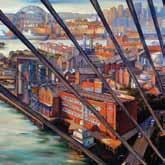
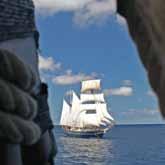
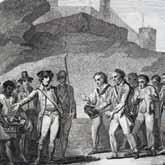

2 Bearings
Celebrate 20 years with the director
6 Pirrama and Pyrmont for pupils
A history program for secondary students explores our location’s dynamic evolution over the years
16 HM Bark Endeavour over the top
The replica’s adventures from Darwin to Fremantle
18 Taronga Zoo goes to sea
An Aboriginal education officer voyages on our Endeavour replica in James Cook’s controversial wake
22 Australian pirate tales
Far less well known than bushrangers, dozens of convicts turned pirate during colonial times
29 Members message and summer events
34 Summer exhibitions and attractions
36 H20 under the microscope
Water, the most crucial resource of all, is the subject of our major summer attraction
40 Maritime history publishing booms
The biennial maritime history book prize offers bigger awards and a new category for communities
42 Lady Denman Maritime Museum
A series on maritime heritage around Australia visits south-coast NSW’s award-winning complex
48 Australian Register of Historic Vessels
New additions to this important national database
52 Tales from the Welcome Wall
Vietnamese refugee survives a sea of troubles
54 Collections – a most remarkable trophy
From the era of the big, open 22-footers
56 Readings
The amazing spice trade; biography of Captain Cook
58 Currents
Thistle sails; sustainable seafood; round the museum
63 Sponsors
Lucky lass wins an Antarctic adventure
December 2011 January February 2012 Number 97 Contents 2 22 6 Cert no SGS-COC-006189
Signals
42 16
S I g NALS 97 D e C e MB e R 2011 T o F e BR u AR y 2012 1
Bearings from the director, Mary-Louise Williams
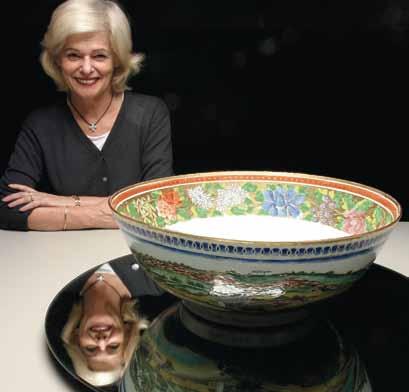
This is director Mary-Louise Williams’s final column, as her retirement – after 23 years at the Australian National Maritime Museum – coincides with our celebrations of 20 years since the museum opened to the public.

On 29 November 1991 the Australian National Maritime Museum opened for business in a brand-spanking-new building perched confidently at the northern end of a recently redeveloped Darling Harbour, Sydney’s great project for the 1988 Bicentenary of European settlement. The museum’s earlier genesis was a 1970s report to the Australian Government arguing a more vigorous support for the arts, and for creating both a national museum and a national maritime museum. It was a time of enormous world-wide enthusiasm for museums and the arts – the like of which we may never see again.
Many people contributed to the birth of this young museum and the shape of its future. A few, both staff and volunteers, are, like me, still working here today. It’s not easy to chronicle the museum’s marvellous achievements and stand-out moments in just a few pages, but I think I can speak for us all when I say that it has been an exciting learning experience, a challenge and a lot of fun.
Some of our earliest mentors warrant particular mention. A much-respected director of a UK national museum, Richard (later Sir Richard) Foster, drew up an architectural brief in the 1980s. His concept of a museum was innovative, contemporary and soundly based both on good collections management and community service. I met Richard while finishing off my MA and working part-time with a community museums advisory service based at the Powerhouse Museum. His early plans for the maritime museum impressed me – except, as an idealistic young student, for the specification of a director’s private bathroom, which I thought rather elitist. Little did I know that one day the bathroom would be mine, and would become much appreciated!
A draft collection plan was written by gifted historian Peter (now Professor)
S I g NALS 97 D e C e MB e R 2011 T o F e BR u AR y 2012 2
left: Director Mary-Louise Williams with a rare Chinese export porcelain punch bowl of about 1820, decorated with a panoramic view of Port Jackson around the base. uSA gallery collection, gift from Peter Frelighuysen. Photographer A Frolows/ANMM
below left: Mermaid figurehead on the bow of Queen Marie-Antoinette’s launch (1777), from the exhibition Les Génies de la Mer. Painted and gilded wood, 180 x 168 x 86 cm. Photographer Arnaud Fux, Musée national de la Marine
right top to bottom:
Visitor services staff with some of the museum’s earliest volunteer guides on museum destroyer Vampire in 1992. Photographer Jenni Carter/ANMM
Launch of the uSA gallery in January 1992 by political luminaries long-since eclipsed: President george and first Lady Barbara Bush; Prime Minister Paul and Mrs Anita Keating; NSW Premier Mr Nick greiner. Photograph by uS Information Service
Museum staff gather – as many as could be spared from their daily duties – with the Endeavour replica shortly before it sailed off on the Australian circumnavigation in April 2011. Photographer A Frolows/ANMM
Spearritt and another exceptional figure, Vaughan Evans, after whom our excellent public research library is named. Vaughan, whose profession was in insurance, was a true Renaissance man with a vigorous love of museums and an exceptional knowledge of maritime history. The core of their plan with its encompassing breadth of themes was that this would be a true museum of the people, and that it would reflect the rich stories and the full, hitherto little-explored scale of our connection with the sea. The legacy of that plan remains with us today and has contributed much to our success.
The initial plan was to open the museum in 1988, the Bicentenary year. Various setbacks of an industrial and political nature – compounded perhaps by the fact that we were a national, Commonwealth-funded museum based in Sydney – saw the opening delayed for three years. That delay gave the first permanent director, Dr Kevin Fewster, appointed in 1989, myself as senior curator and our team of curators, designers and other dedicated museum staff the chance to add our own contributions and increase the depth of the fledgling collection, the opening exhibitions and the fit-out of the dramatic building developed by Sydney architects Cox Richardson.
Bearings



S I g NALS 97 D e C e MB e R 2011 T o F e BR u AR y 2012 3
Bearings



Without question our first years were a time for learning and growth in an evolving location. We stood then at the very extremity of the Darling Harbour tourist precinct, bordered by a wasteland of redundant industry and waterfront, depicted graphically on page 9 of this issue of Signals. Now, 20 years later, we’re right in the middle of a colourful and vibrant environment that includes Star Casino and a bustling commercial and residential quarter. One of our own contributions to this urban redevelopment is the adjacent Wharf 7 Maritime Heritage Centre, which houses our collection, laboratories and workshop, the Vaughan Evans Library, design studio, and our cousins at the Sydney Heritage Fleet whom we sponsor with office accommodation and a berth for their wonderful 1874 iron barque James Craig
In that 20-year period we’ve grown into a confident cultural organisation connecting each year with millions of people in Australia and abroad. Some visit our exhibitions here in Sydney or at other sites around the country, while the range of people who use our services increases every year as researchers, students and audiences connect with the collection, exhibitions and programs online. This demand will continue to grow and provide us with new challenges.
At last count we have staged well over 120 temporary and travelling exhibitions–including a rich range of shows and programs developed as collaborations with major museums here and abroad. Partners have been from the UK and the USA, Portugal, Italy, France, The Netherlands, Denmark, Sweden, Finland and Chile.
My favourite? One might say that passion leapt ahead of logic when I saw an exhibition of glorious masterpieces of French naval sculpture at the Musée national de la Marine in Paris in 2003. The logistics of transporting these grand figureheads and ship carvings, dating as far back as the Baroque period and the court of Louis XIV, were mind-bending, but the skill of our exhibitions and registration staff who shared my determination resulted in a stunning and much applauded 2005 show, Les Génies de la Mer The Sydney Morning Herald called it ‘the year’s most astounding exhibition’. The friendship we developed
with the Paris museum has resulted in further collaborations such as the magical collection of toy boats in Bateaux Jouets, and opened the way for us to borrow from the Coco Chanel Archive for our playful show Sailor Style.
Our award-winning exhibition and online program about the touching story of post-war child migrant programs opened last year to much acclaim. On their own – Britain’s child migrants was developed in conjunction with the National Museums Liverpool in the UK and is travelling extensively around Australia with support from an Australian Government grant. It recently won the best exhibition in the 2011 IMAGinE Awards presented by Museums and Galleries NSW, Museums Australia (NSW), Regional and Public Galleries NSW and Museums Australia.
Connections with overseas organisations like these complement our active involvement in world-wide maritime heritage through the International Congress of Maritime Museums and other professional organisations, which have given the Australian National Maritime Museum a high international profile. The significance of these close working relationships on Australia’s international affairs cannot be underestimated.
One of our strongest international links has been forged through the USA Gallery, a generous Bicentennial gift from the American people that focuses on our shared Pacific history. The gallery was opened by President George Bush in 1992 and visited with much flurry by his son George W Bush when Sydney hosted the APEC summit in 2007. US ambassadors and consuls have maintained a close friendship with the museum through the USA Gallery and participation in the consultative committee that oversees its rich displays and collection.
And memorable events? There have been many. Perhaps our most unexpected guests arrived on a bright, wet winter’s morning in August 2004. Jan at reception rang me to say that two whales were wending their way towards the museum’s wharves. Sceptically I made my way down to the waterfront… and sure enough there were two adult Southern Right whales lolling about in our waters inspecting heritage vessels in their
S I g NALS 97 D e C e MB e R 2011 T o F e BR u AR y 2012 4
Britain’s The Sunday Times recently named us one of the top 12 ‘cool museums’ in the world... the only Australian one on the list!
acquired by the museum in 2005. It was with considerable trepidation that I thanked the Federal Arts Minister of that time, Senator Rod Kemp, when he proudly announced that he would purchase the magnificent, Western Australian-built replica for us and bring it back from the UK where it had been based for some years. Running a museum is one thing but managing a fully surveyed, ocean-going square rigger is another. I was a little stunned, but one comment I managed to make was that it would need a dowry, which fortunately his government provided.
Bearings
of which the museum can rightly be proud, among its many achievements. We have developed an impressive range of programs to service museums and community associations that collect and care for maritime heritage. As well as travelling exhibitions, these include a heritage grants program, internships for volunteer museum workers and advisory services. One of the most significant is the Australian Register of Historic Vessels that for the first time links associations, individuals, clubs and museums all over the country.
own sweet time. A stupefied crowd of onlookers was as spellbound as I was, watching these glorious creatures making a quiet museum visit.
Far more hectic was my first full year as director when the museum hosted key hospitality sites during the Sydney 2000 Olympic Games. These included Austrade, the Japanese Olympic Committee, the United International Pentathlon Union, and that crowd-pleaser the colourful Dutch Olympic headquarters, Heineken House. We had a rolling throng of party goers, royal VIPs, Olympic sportsmen and women – and alongside, the world-famous replica of the 17thcentury Dutch East Indiaman Batavia, which set its sails at sea for the first time ever during the Sydney visit. The museum pulsed with action day and night.
Our unique collection has grown enormously in quality and scale since its beginning in the late 1980s in a rented warehouse lined with shiny, new – but empty – storage racks. Among the enormous, fascinating diversity of its hundreds of thousands of objects and archive items I will always hold a special admiration for one collection, Saltwater: Yirrkala bark paintings of Sea Country The 80 works by Yolngu artists from Arnhem Land have an artistic, social and political significance that is overwhelming.
For scale and impact on a maritime collection you couldn’t go past the replica of James Cook’s HM Bark Endeavour,
Getting the vessel here was one event I’ll never forget. Endeavour arrived from the UK in April 2005 and anchored to clear Australian customs in Botany Bay –appropriately, of course, as James Cook’s original landing place in 1770. A huge, celebratory home-coming had been planned for the entry into Sydney Harbour early the next day, with a welcome regatta of many vessels to meet Endeavour at Sydney Heads. I was on our naval patrol boat Advance with VIPs and press; helicopters flew overhead and James Craig stood to sea. Crowds lined the shore and hundreds of school children waited expectantly at the museum to greet the famous ship. The Minister had boarded Endeavour in Botany Bay to make the final passage and triumphant entry into Sydney Harbour. Then at 11.00 am my mobile phone rang. It was the editor of Signals on board Endeavour, relaying the tragic news that they had run hard aground in Botany Bay – not just on any reef but on one that James Cook had first charted in 1770 – and the tugs just couldn’t shift it.
And there Endeavour stayed until the tide rose again. It wasn’t until 10.00 pm that the ship limped home wounded and sorry, with one tired Minister and the welcome team at our wharves reduced to a stalwart handful. Since then, I am pleased to report, Endeavour is back in top shape and is the museum’s greatest ambassador for outreach, navigated safely and well under our management to visit regional and remote ports around the country. At this time the replica is half way through a historic 13-month circumnavigation of Australia.
Endeavour is the most far-reaching of the community and outreach services
We couldn’t operate Endeavour on its out-of-port visits or indeed most of our other programs here in Sydney without the enduring support of our huge army of volunteers. Last time I looked we had well over 1,000 active volunteers with more than 500 in Sydney. This is a vital workforce, one that adds great value to the museum as I hope it does to the lives of the volunteers themselves.
The end of 2011, as we celebrate the museum’s 20th year of opening to its public, is particularly significant for me personally since it is also the time when I step down as director. I’ve had the privilege of 23 years working in an extraordinary institution, first as senior curator, then as assistant director and for the past 12 years as director. I have worked alongside many talented and committed staff and hard-working chairs like Peter Doyle, Kay Cottee, Mark Bethwaite, Peter Sinclair and now Peter Dexter – and our many other Council members too. I will truly miss them all and thank them for their help and their support. I wish my successor well in the coming years. He or she will have challenges, the frustrations that come with the turf, but most of all – great satisfaction.
opposite top to bottom: out and about – ANMM Members on tour to southern India, exploring the backwaters of Kerala state. Photographer J Mellefont/ANMM 2003 exhibition Antarctic Heroes. Photographer A Frolows/ANMM
exhibition Banumbirr Morning Star Poles was one of many that over 20 years have featured the vibrant art and cultures of coastal Indigenous communities. Photographer A Frolows/ANMM
S I g NALS 97 D e C e MB e R 2011 T o F e BR u AR y 2012 5
Pirrama and Pyrmont for pupils
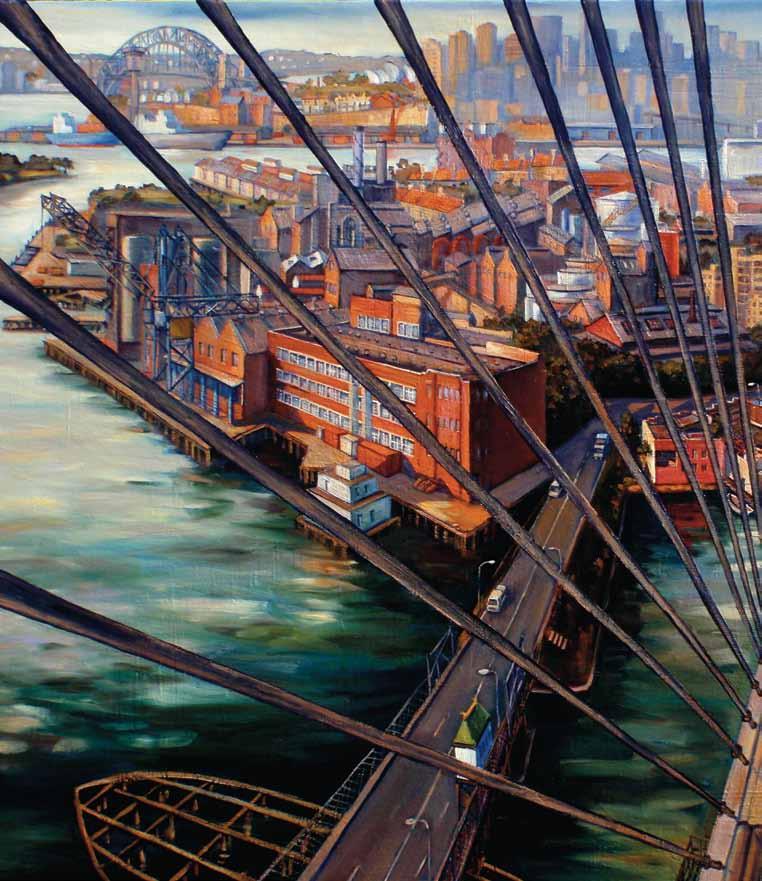
S I g NALS 97 D e C e MB e R 2011 T o F e BR u AR y 2012 6

The Australian National Maritime Museum occupies a site that’s witnessed centuries of maritime activity, in a locality that’s been shaped and reshaped as a human and an industrial landscape.
ANMM education officer Lauris Harper explains how this dynamic part of Sydney is interpreted to schools through a special museum learning experience.
Closing the gap – from the top of the ANZAC Bridge by Jane Bennett, 1995. oil on canvas 91 x 122 cm. To the left of the nearly completed bridge deck is the entire CSR site with its wharves and cranes prior to its redevelopment by Lend Lease. Around the northern Pyrmont shore can be seen the Jones Bay wharves, part of the Royal edwards Victualling yard and the Australian National Maritime Museum. All the illustrations for this article are works by Sydney artist Jane Bennett (see panel page 15) and are reproduced by kind permission of the artist.
S I g NALS 97 D e C e MB e R 2011 T o F e BR u AR y 2012 7
More than just a neighbourhood, a work area and part of the harbour complex that is the backdrop to Sydney’s CBD, Pyrmont has a history that is interesting, rich and diverse. Pioneered by leading colonial families, its present appearance reflects the forces of social and industrial development and its maritime location. How do we pass on this diverse history to our youth, and in particular how do we do that at the Australian National Maritime Museum?
The study of history is compulsory for all New South Wales students to the end of Year 10. During Years 7–8 and 9–10, students must complete a history site study that might focus on a museum, a suburb or an industrial site. At the museum we offer Year 9–10 students a two-hour Pyrmont history site-study walk linked to the NSW Board of Studies History Syllabus, which says:
Site studies enable students to understand their historical environment and participate actively in historical inquiry. They can offer a means of interpreting the past and/or recognising how human occupation and use of the site has changed over time, and lead to an understanding of the context in which changes have occurred. They… fashion a lifelong interest in history.
As museum education staff were devising the walk, the historical environment, inquiry and interpretation of Pyrmont’s past lent itself to the following segments: early history, the world of wharves, the railways, industry and the Pyrmont Bridge, community living, and redevelopment.
Early history
Students are asked to mark certain points of modern-day interest on an 1800s map and also to consider the Indigenous presence, white occupation, and shipping usage of Cockle Bay. The Pyrmont peninsula was occupied by the Cadigal people who called it Pirrama. The arm of the harbour on which the museum stands was known as Cockle Bay, for the large middens and shells found there. In 1826 it was renamed Darling Harbour after Governor Ralph Darling.
Pyrmont and the adjacent Ultimo were divided between two well-known pioneers, Captain John Macarthur and Surgeon John Harris. In 1799 Macarthur acquired 55 acres (22 hectares) originally granted to Thomas Jones (commemorated in Jones Bay and Jones Street).
Macarthur’s holding at the northern end of the peninsula, which he named
Pyrmont after spa springs in Germany, divided Cockle Bay from Blackwattle Bay and with its deep-water access had good potential for development. Gums, wattles and other native trees covered its sandstone ridge. John Harris owned much of the remainder of the peninsula, acquiring parcels of land from 1796 and receiving large grants from Governor King in 1803–06. As neither owner found a way to exploit the land due to its difficult terrain, the Aboriginal people were allowed to roam free and use the area in their traditional ways.
By the early 1800s Sydney had become a regular port of call for shipping between Europe, China, and India. It was also a refitting port for the many American and British whalers operating in the Southern Oceans. British ships were concentrated around Sydney Cove and foreign ships in Neutral Bay. This left the tidal Cockle Bay mudflats to accommodate the overflow of shipping from Sydney Cove.
World of wharves
The surviving Pyrmont wharves reflect changes in topography, industry, urban growth, themes of retention, conservation or redevelopment, and the stories of those wharves that have disappeared. Using the site, photographs and general knowledge, students draw conclusions about wharf usage, conservation and heritage issues, and the economic history of Sydney.
The Hunter River Steam Navigation Company (later the Australasian Steam Navigation Company) acquired Darling Island from Edward Macarthur in the 1840s to establish an engineering and maintenance yard, and by the 1890s it had facilities for handling wool, live sheep and frozen meat. Over the 19th century land reclamation and seawall construction joined Darling Island to the shore.
The Sydney Harbour Trust, established in 1901 to plan for future shipping and commercial needs, erected extensive wharves in Jones Bay with a specially constructed pier and seawall designed to deter disease-harbouring rats from swimming ashore from visiting ships.
The historic Jones Bay Wharves 19, 20 and 21 have been retained for commercial offices, studios and restaurants.
Pyrmont Wharf 13 on the eastern shore of Darling Island was used variously for freight and trade, boarding troops during World War 2, disembarking migrants and refugees, and berthing cruise ships after containerisation reduced its usefulness for cargo handling from the 1960s. Dominating Darling Island is the early-20th-century Royal Edward
Substantial evidence remains of the quarries that supplied public buildings in Sydney with stone of superior hardness, texture, and colour
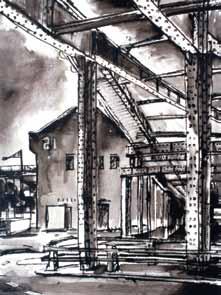
clockwise from above:
Jones Bay Wharf 2 1997, ink on paper 40.5 x 30.5 cm. Above is the fly-over roadway that leads to the upper level of the Jones Bay wharves.
Pyrmont Goods Yard from top of Pyrmont Power Station 1989, ink 105 x 131 cm. The museum’s locale while it was being constructed included the surviving railway yard nearby. Left to right along the waterfront are Wharf 13 at Darling Island, and Wharves 7, 8, 9 and 10 grouped to the left of the museum building.
Sydney Harbour from the CSR 1991, ink on paper. The mooring pens of the former NSW Water Police depot can be seen, with Wharves 22 and 23 in the process of being demolished. Residents fought hard to fend off more apartment development on the Water Police site, bought for $11M by the City of Sydney Council in 2005 to create Pirrama Park as part of a continuous harbourside walk that now follows most of the Pyrmont foreshore, from glebe Island Bridge to Cockle Bay.
S I g NALS 97 D e C e MB e R 2011 T o F e BR u AR y 2012 8


S I g NALS 97 D e C e MB e R 2011 T o F e BR u AR y 2012 9

Victualling Yard which has a long association with Australia's naval history. Closed in the 1970s, some buildings were demolished and others turned over to tenants. Today the Darling Island peninsula is part of an urban regeneration strategy, and the last decade has seen it totally reshaped by offices, apartments and parkland.
The New Railway Jetty, where this museum’s Wharf 7 Maritime Heritage Centre stands, was built in 1905. It played host to thousands of ships and harbour vessels – cargo and coal vessels, shiploads of Australian troops departing for both world wars, and transit for Italian prisoners of World War 2. Our Wharf 7 facility was designed to reflect the style of the Federation-era wharf buildings that survive in Walsh, Jones and Woolloomooloo Bays.
The railways
Little evidence remains today of the railways and goods yards that existed around the museum site until recent decades, although railway tracks are still to be found embedded in the dockside next to Wharf 7, where James Craig moors. By using old photographs,
brief historical information and detection skills at Wharf 7, students are able to piece together the important relationship between the rail system and the port, and the rise and fall of the Darling Harbour Goods Yard.
The Sydney Railway Company, formed in 1849, bought 7½ acres (3.03 hectares) of land from the Harris family to build a railway line joining the Sydney Rail Terminus, near present-day Central Station, to proposed wharfage facilities at Darling Harbour. The railway, ultimately connecting Darling Harbour and Parramatta, was opened in 1855 but it ended short of Pyrmont Bridge. Here the bay was too narrow and shallow to accommodate the wharfage needed to support the industrial and agricultural boom – including wool, a mainstay of the economy – that came after the 1850s gold rushes. In 1891 the rail was extended north beyond Pyrmont Bridge to tie the waterfronts of Pyrmont and Ultimo into a single economic unit, and serviced coal, timber and wheat wharf sidings on Darling Island.
By the 1960s Darling Harbour Goods Yard covered 22 hectares, contained nearly 50 kilometres of track and handled
13,500 trains a year. However, the following decades saw the swift demise of the goods yard as wool stores were relocated to Yennora due to intense congestion on the peninsula, and new container terminals were built at White Bay and Port Botany. The last train left in 1984 when plans for the Darling Harbour recreation precinct were announced.
Industry and Pyrmont Bridge
With growth in population and traffic, the Australasian Steam Navigation Company based on Darling Island began lobbying for a bridge across Darling Harbour in the 1850s, arguing that Sydney’s wharf accommodation was quite inadequate and that Pyrmont offered suitable wharf sites. Many other Pyrmont businesses were disadvantaged by the lack of a bridge. Fine yellow sandstone from Pyrmont quarries, in demand for Sydney buildings, was being dragged around the bay along deteriorating roads. The Pyrmont Bridge Company opened its central swing bridge in 1858, resulting in further industrial growth – iron works, boatbuilders, coal and timber merchants, engine works, iron rolling mills and associated support industries.
S I g NALS 97 D e C e MB e R 2011 T o F e BR u AR y 2012 10

The huge R Goldsbrough and Co wool store, built in 1883 and covering one third of the peninsula, was one of 20 rising in the following 50 years. Burnt down in 1935, it was replaced by an even larger building. Rapid expansion of the wheat industry after World War 1 increased the need for flour mills, such as Gillespie Brothers’ Anchor Flour Mill at 52 Union Street. Ultimo and Pyrmont powerhouses, built to meet industry’s energy demands, relied on the railway to bring in coal. Even more power was needed for the second Pyrmont Bridge, opened in 1902 with the world’s first electrically operated steel opening span, and for trams running along Harris St and across Pyrmont Bridge. Cleaner power stations built elsewhere in the mid-20th century allowed the Ultimo power plant to be redeveloped as the Powerhouse Museum, and the Pyrmont power station was demolished to make way for Star Casino. The façade of the 1904 administration building is all that remains, incorporated into a corner of the casino.
Substantial evidence remains of the quarries that supplied public buildings in Sydney with stone of superior hardness, texture, and colour. They employed over
300 local men in the late 19th century: quarrymen, blacksmiths, engineers, farriers, wheelwrights, carpenters and others. Robert Saunders operated three main quarries, Purgatory, Hell Hole and Paradise, which stretched towards Johnston’s Bay where he had his own wharf. The current topography reflects the depth of digging, allowing students to empathise with the quarry workers’ hard labour.
The Colonial Sugar Refining Co opened a refinery in 1877 on five acres (2.02 hectares) of deep-water frontage. The CSR site, with its distillery and later a building materials plant, provided work for many thousands of men as well as housing and community buildings. By 1980 CSR was the second-largest Australian company. It relocated in 1995 and the site is now a major urban redevelopment including the upmarket Jackson’s Landing waterfront apartment complexes, with public access to the waterfront restored. Students walk past the Tablet House where sugar was cut into cubes, and other repurposed industrial buildings, to experience the scale and economic contribution of the CSR works.
The New Railway Jetty, where our Wharf 7 Maritime Heritage Centre stands, moored thousands of ships and harbour vessels carrying cargo and coal and Australian troops departing for wars
oil
board 41
122 cm. This fine example of early public housing was designed by the architect Professor Leslie Wilkinson and built in 1925. S I g NALS 97 D e C e MB e R 2011 T o F e BR u AR y 2012 11
Ways Terrace 1994
on
x
The museum’s wharves where its historic vessels are moored echo the many commercial finger wharves that once lined both sides of Darling Harbour
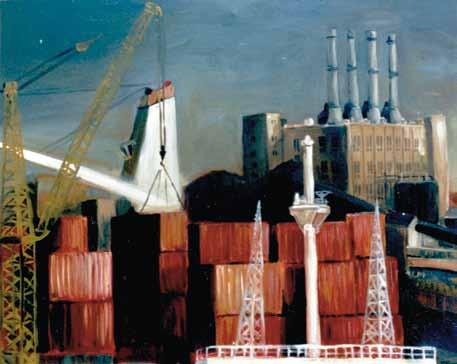
Community living
The changing fortunes of Pyrmont’s industrial history are reflected in community developments. Fortunately many fine examples of older public and private buildings remain for students to see as they walk through the district.
After the opening of the Pyrmont Bridge many roads (such as Murray, John, Church and Mill) were laid down. Street lighting was installed in the early 1860s and a regular water supply was connected from Crown Street Reservoir, Darlinghurst, to Harris Street in 1861. It still exists today. In 1867 there were over 400 households living in workers’ cottages and terraces with shops and pubs (up to 25 at one stage) in the areas north of Union St and Pyrmont Bridge Road. By 1879 there was a council swimming pool at the end of Point Street that became an important social hub. Presbyterian, Anglican, Methodist, Congregational and Catholic Churches dotted the area.
Nursery. Ways Terrace, dating from 1925, reflects attitudes to public housing in Sydney during the period. It exhibits many of the characteristics of inter-war Mediterranean style in its wall surfaces, windows, roof pitch, loggias, balconies and other features.
above: EP5 Container Ship 1988, oil on board 122 x 152 cm. The landmark Pyrmont power station, which has made way for a casino, was the district’s highest landmark. The viewer looks across a container ship being unloaded alongside Darling Harbour’s eastern wharves (today awaiting redevelopment as Barangaroo).
opposite: Paradise Quarry, CSR 2000, oil 61 x 45 cm. Sandstone hewn from the Pyrmont quarries went into the construction of many of Sydney’s finest buildings, including the university of Sydney Quadrangle and the Australian Museum.
Parents had a choice of Anglican and Catholic schools, the National School in Mount Street and private schools. The Murray Street School, built in 1876, was resumed by the Railways Department in 1914 to expand Darling Harbour Goods Yard. In 1884 the third Pyrmont Public School was built in John Street and remained in use until 1933. It was then used as a hostel for the unemployed and in 1945 became an annex of Sydney Technical College. It is now Sydney Day
Life in Pyrmont in the 1930s and 40s saw a steady onslaught on residential amenity. Population decline ran at about 5% per year (from highs of nearly 20,000) and school numbers dropped. From 1951 until 1971 the State Government zoned the peninsula to make any land use acceptable. The cottages bound by Harris, Scott, Point and Bowman Streets were bought by Council. The precinct became famous as a squat, and by the 1990s residents were attempting to save the remaining houses as representative of Pyrmont Point domestic architecture. Some were retained. The closure of the power stations, relocation of the wool stores, the debris of obsolete industries and unviable businesses began 20 years of uncertainty for the peninsula, where the population declined to just a few thousand.
Redevelopment
The last major upgrade of port facilities at the northern end of Darling Harbour occurred in the 1960s and 1970s. In the 1980s Pyrmont’s wharves closed, finally superseded by technological changes in cargo handling and the accelerating shift of industrial shipping out of Sydney
S I g NALS 97 D e C e MB e R 2011 T o F e BR u AR y 2012 12

S I g NALS 97 D e C e MB e R 2011 T o F e BR u AR y 2012 13
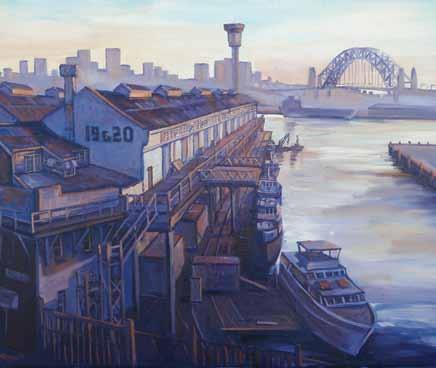
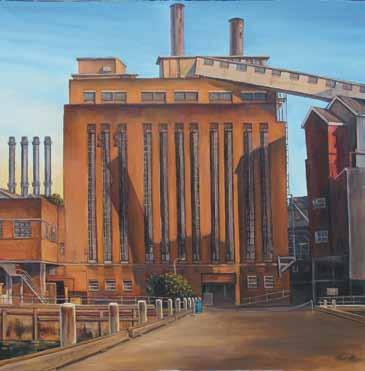
Harbour. Government and developers produced numerous plans and discussion papers for the redevelopment of Pyrmont, to attract residents back into the city and revitalise it.
The planning of freeways cutting great swathes through existing housing areas and parks led to angry public meetings, clashes with police, green bans and the emergence of resident action groups.
The Wran State Government (1976–86) temporarily halted freeway construction and then in the 1980s began again, with fewer routes and more mindful of housing. Resident action saved Pyrmont Bridge – old and decrepit to the road and harbour authorities but priceless and historic to others. It has proved to be a vital pedestrian and bicycle link between a revitalised Pyrmont and the city.
In 1984 the Wran government announced the Darling Harbour Redevelopment Project, to be completed for the 1988 Bicentenary of European settlement of Australia. When it opened to the public in 1988 it included Tumbalong Park, the Exhibition Centre, Chinese Garden, Powerhouse Museum, Monorail and Sydney Aquarium. In 1989 the Sydney Convention Centre opened. The precinct would come to include major hotels and the Imax cinema.
In the 1990s the State Government set up the City West Development Corporation to oversee urban renewal
projects across Pyrmont, Ultimo and several other CBD fringe areas. In 1999 it became the Sydney Harbour Foreshore Authority (SHFA). These bodies have overseen rapid change to the City West region. The 2001 census revealed a population grown to 11,915 and by the 2006 census this had ballooned to 17,375. The highest rate of population growth occurred in Pyrmont where high-rise residential buildings replaced abandoned industrial sites. It has attracted a vibrant and frequently youthful demographic that includes many CBD workers.
Pyrmont has been chosen as the headquarters for modern media, design and information technology organisations including Fairfax Media, Thompson Reuters, Big Pictures Australia, Channel 7, Channel 10, Macquarie Radio and the ABC. The Pyrmont-Ultimo peninsula has become a creative hub for the city attracting hundreds of small to medium businesses in support of these enterprises. They have been established in a variety of office spaces from converted terraces to strata office blocks to large ultramodern corporate headquarters.
One important cultural component of the Darling Harbour redevelopment is the Australian National Maritime Museum, opened exactly 20 years ago on 29 November 1991. The wharves where its historic vessels are moored echo the many commercial finger wharves that once
lined both sides of Darling Harbour. While as a national cultural institution funded by the Australian Government its brief is to represent the maritime history and heritage of the entire nation, it also has a special role in interpreting the maritime, industrial and social past of its location on the historic Pyrmont peninsula, for the next generation to understand.
The museum’s Pyrmont history sitestudy walk for secondary students is one important way in which we undertake this role.
above left to right:
Dawn Jones Bay Wharf 2000, oil on canvas 41 x 51 cm. Just to the west of Darling Island, the wharves have been refurbished for small business occupants and restaurants since this study of the facility was made, although traces of the railway lines still remain.
The Boilerhouse CSR Refinery from the jetty 1991, oil on canvas 91 x 91 cm. The four smokestacks of the old Pyrmont power station are visible at left. Today this building has been refitted as offices and renamed by developers ‘The elizabeth’, a title with little connection to its industrial history.
The Terminus and the Point 2011, oil on canvas 31 x 61 cm. Very few of Pyrmont’s dozens of pubs remain in business in 2011, now either boarded up, demolished or housing small businesses.
S I g NALS 97 D e C e MB e R 2011 T o F e BR u AR y 2012 14

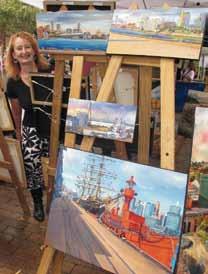
Jane Bennett, artist and industrial history warrior
Sydney artist Jane Bennett has devoted over 30 years to building a comprehensive archive of work documenting the changing urban landscape of Sydney. Working in a variety of media she paints ‘en plein air’, and has set up her easel on demolition sites and giddying, windswept eyries such as the top of a condemned power station or the unfinished tower of ANZAC Bridge, to capture the elusive spirit of place. She been granted unprecedented access to areas restricted to the public, as artist-in-residence to many organisations and locations including Sydney Ports Corporation, Barangaroo (‘The Hungry Mile’), the Anzac Bridge, CSR Refinery & Distillery, eveleigh Railway Workshop and this museum’s Classic & Wooden Boat Festival.
you can see more of Jane Bennet's work on the web at http://janebennettartist. blogspot.com/. She is represented by Frances Keevil gallery at 28–34 Cross Street Double Bay, NSW 2028 (02) 93272475.
While her subjects vary, the theme remains constant – the end of the Industrial Revolution and the dismantling of its relics. A chronicler of her times, Jane is equally concerned with history, politics, economics and demographic change. As the momentum of development rapidly gathers, Jane continues to record these areas with an increasing sense of purpose and urgency. Her works have been described as ‘industrial memento mori’.
‘I had originally trained at art school as a figure painter,’ Jane told Signals, ‘but when I was looking for cheap studios in the early
1980s, I began to hear disturbing rumours about the future development of the city. every art student has probably painted a couple of gritty urban images at one time or another. However, when I started to paint Pyrmont I realised that this was different. It would be a tabula rasa – a complete clean sweep of the entire suburb. everything was to change – the buildings, the streetscape, the population, the ambience, the industries, the very purpose of the entire peninsula – most of it under the control of a single developer. Then I understood that what happened in Pyrmont was a prototype for gentrifying every inner city and harbourside precinct, pushing the last vestiges of industry – and its workers – out to the periphery of the city and beyond, never to return. I became both fascinated and repelled by the scenes of destruction, by the scale of this transformation. I experienced great frustration at painting to an unknown but inevitable time limit as buildings were demolished as fast as I could paint them. I’ve found it much easier to paint it than to write about it; I’ll leave it to the historians of the future to calculate objectively whether Sydney has gained more than she lost.’
Jane’s work is represented in The Mitchell Library, State Library of NSW, including Closing the Gap displayed in their 2010 Centenary exhibition; Artbank; Department of Defence; university of NSW; university of Sydney and many regional gallery & municipal council collections. She has been a finalist in and winner of numerous art prizes. JM
above: The artist at Pyrmont Community Fair 2011. Photographer J Mellefont/ANMM
S I g NALS 97 D e C e MB e R 2011 T o F e BR u AR y 2012 15
HMB Endeavour over the top
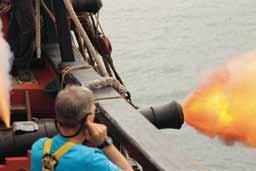

Endeavour ’s arrival in Fremantle is an important milestone in the 13-month circumnavigation – 180 days since the ship left Sydney, and effectively the halfway point of the voyage.
ANMM manager of communications and public affairs Shirani Aththas summarises the voyage across the Top end and down the west coast.
It’s been a colourful voyage for Endeavour and her crew since the ship left Darwin in August. There have been the trials of king tides and strong tidal currents, remote coasts and islands, an amazing array of wildlife, and even an impromptu sea battle… all before returning to her Fremantle birthplace for the first time in a decade.
The west-coast voyage has taken in some amazing scenery from the stunning red cliffs of Cape Leveque to Careening Bay where explorer Phillip Parker King famously carved ‘HMC Mermaid 1820’ on a large boab tree during his survey of Australia 190 years ago. Amazingly nearly two centuries on, the carving was still clearly visible to the Endeavour voyagers.
The ship called in briefly to Broome and Exmouth to change over voyage crews, and made a nine-day visit to Geraldton. Along the way, the voyagers have been astounded by the diverse
S I g NALS 97 D e C e MB e R 2011 T o F e BR u AR y 2012 16
wildlife they have encountered including hundreds of humpback and sperm whales breaching metres from the ship, large sea snakes, dolphins, sharks and even a colony of sea turtles at Serrurier Island. Against this beautiful backdrop, the ship’s crew undertake a daily maintenance program from replacing the pitch between the deck planks to stitching sails and mending chafed ropes. Even the robust forecourse had to be repaired after strong winds blew it out.
In what could arguably be called a battle for freedom of entry, the crew of Endeavour took part in an epic sea skirmish with another Western-Australiabuilt tall ship, Leeuwin II, just off Rottnest Island the day before her return to Fremantle. About 15 miles out to sea, the two ships spied each other through the early morning mist and it wasn’t long before both had closed in and the call went out for ‘all hands on deck’ to manoeuvre the ship.
Under full sail the two ships circled each other, trying to gain the ‘weather gage’ – the advantageous position to windward – looking for the best opportunity to fire their ‘broadsides’ and showing off their sail handling and manoeuvring skills. Leeuwin tried to get the upper hand but Endeavour wasn’t cowed and carefully manoeuvred so that Leeuwin had to fall away to leeward… allowing Endeavour a ‘broadside’ from a port gun. Endeavour then quickly wore ship again, delivering another round of fire from the starboard gun and thereby ensuring victory! For Endeavour Captain Ross Mattson victory was particularly sweet, since the Master of Leeuwin is Chris Blake who commanded Endeavour for many years before ownership transferred to the Australian National Maritime Museum in 2005.
The following day more than 4,000 people lined the Fremantle foreshore to welcome Endeavour back to her ‘spiritual’ home where she was built and launched in 1989–93. Dozens more in pleasure craft and sailing boats escorted her into Fremantle’s harbour. It was certainly one of the biggest welcomes the ship had received since leaving Sydney. The replica opened to the public for three weeks in Fremantle and welcomed more than 10,000 visitors on board. It then made a brief visit to Bunbury before returning to Fremantle.
Throughout December Endeavour will take part in the Perth 2011 ISAF Sailing World Championships, providing a unique 18th-century contrast to the sleek, 21st-century competition craft. During
this time, ISAF will be hosting a series of day sails and Great Cabin dinners on the replica. Then following its Fremantle visit, Endeavour will proceed down the WA coast to Albany before crossing the Great Australian Bight to South Australia, Tasmania, across Bass Strait to Victoria and then home to Sydney by May 2012.
It’s easy to forget about the extensive onshore support, organisation and equipment that goes into making the Endeavour circumnavigation possible. For the last seven months Endeavour shipkeeper Craig Lockwood has been circumnavigating Australia – but by road rather than sea. Craig has followed the voyage, every mile of it, in a seven-metre ISUZU truck, ensuring all the necessary equipment is set up in port in time for the ship’s arrival. The truck is packed with heavy staging equipment to accommodate the ship’s gangway and ensure people can board safely. It carries ticketing and merchandise tents and their equipment, safety barriers, signage, information panels to provide visitors with more information on the history of the ship, shade marquees and even a portable PA system!
Craig has called the truck home since leaving Sydney and travelled more than 13,000 km of dusty country and outback roads from port to port, passing hundreds of road-trains and roadhouses. He’s rumoured to have visited every Red Rooster on the seven-day trip from Darwin to Fremantle!
Not only is Craig always the first to arrive and the last to leave each port, to ensure the infrastructure is safely set up and packed down, he is also there to catch the lines when the ship berths, run training sessions for new volunteers with voyage manager Trish Pascuzzo. He is on hand each day to run errands, answer questions and ensure that all runs smoothly.
So keep an eye out for Craig and the big truck with Endeavour emblazoned on the side – it’s come a long way!
Over the past seven months the ship has called in to nine ports and opened to the public in six, welcomed over 40,000 visitors on board including 4,000 school children, and sailed more than 6,500 nautical miles with over 300 rotating voyage crew



opposite: Sail training barquentine Leeuwin II, seen though Endeavour’s rigging, hoves into view off Rottnest Island, leading to an exchange of gunnery ‘salutes’. All photographs by ship’s crew/ANMM
this page top to bottom: An osprey alights on the bowsprit, between exmouth and geraldton; whale-spotting between geraldton and Fremantle; turtle mating season observed on the Broome to exmouth voyage; Kimberly coastline.

S I g NALS 97 D e C e MB e R 2011 T o F e BR u AR y 2012 17
Taronga Zoo goes to sea

HMB Endeavour
S I g NALS 97 D e C e MB e R 2011 T o F e BR u AR y 2012 18

Staff from Taronga Zoo have participated in programs carried out on the museum’s Endeavour replica during her current Australian circumnavigation. Taronga’s Aboriginal education officer Natasha Mooney joined the ship’s voyage crew on the Queensland coast, and writes of her thoughts and experiences.
As the Australian National Maritime Museum’s replica of James Cook’s HM Bark Endeavour retraced the original ship’s course up the Australian east coast earlier this year, a unique partnership with Taronga Zoo was utilising the skills and expertise of Taronga scientists in some of the programs that the ship is undertaking during her voyage. That’s what brought me, an education officer at Taronga Zoo, aboard the Endeavour. My role was to help develop educational resources about this research for the zoo and the museum. So I was earning my passage at the same time as having a new experience that was challenging in several ways.
As the Aboriginal education officer at Taronga Zoo and an Aboriginal person of the Yuin Nation on the south coast of New South Wales, my usual role is to teach lessons linking Aboriginal culture and spirituality to animals, while highlighting the practices of sustainability. Aboriginal people lived in harmony with their environment, developing and maintaining healthy animal and plant populations for thousands of years. At the zoo, I interact with culture and history every day, which brings into focus the various impacts of colonisation on our land, animals and peoples.
Taronga Zoo is Cammeraigal land and is a perfect place to highlight the contrast of old and new. We are able to look out over Sydney Harbour and view the dense bushland on the tip of Bradleys Head, which is not at all dissimilar to how it would have looked in 1788 when the first of the convict ships sailed into the harbour. We then look further afield to the Botanic Gardens, the landing site of the First Fleet and the land of the Cadigal
people. Despite the bridge and buildings, with a little imagination you can see how it would have been 250 years ago.
I’ve got to admit that while I have always held a certain curious fascination for the hardy, brave explorers who travelled the seas, and marvelled at the amazing skills those past mariners used to get their small vessels across oceans in the extremes of weather, my interest in participating in this type of travel wasn’t all that high. Faced with the prospect of joining the Endeavour replica’s voyage, I think it would be fair to say that I was as keen to sail as those unlucky young men who, in days gone past, woke up press-ganged onto a ship after a night out on the town!
While I actually grew up in and around the water on the NSW south coast, I had no sailing experience at all, so it was with some trepidation that I approached the milling crew all proudly wearing bright blue shirts in the foyer of Reef IQ in Townsville. They were eagerly waiting to embark on Endeavour for the Townsville to Cairns leg of the ship’s circumnavigation of Australia. I was the dubious one, I admit. Although I had studiously read the manual, trying to memorise lines, knots, sails and various other bits of essential nautical information, it only served to highlight how much I didn’t know and how much there was for me to learn.
The descriptions of cramped living quarters and conditions didn’t quell my concerns.
It also didn’t help that from the moment I stepped aboard we were inundated with directions on safety procedures, obeying instructions and the ship’s order of command. I was beset with the urge to jump ship before we had even left the dock! Nonetheless I did stay aboard and with the usually flurry of heaving anchor and making sail we got underway. While motoring out of the harbour was peaceful, the excitement of all on board was palpable – from us newbies to the professional crew. It was a beautiful day and that set the tone for what was to come.
After the turmoil of those first confusing hours, I began to enjoy the gentle roll of the ship and the peace that comes with being away from society, dispensing with technology and getting back to nature. The sense of camaraderie and togetherness that I felt with the other members of my group, the Mizzen Mast watch, was strengthened as the days rolled from one to the next. There is no doubt that the life of a sailor was, and still
S I g NALS 97 D e C e MB e R 2011 T o F e BR u AR y 2012 19
above: Taronga Zoo Aboriginal education officer Natasha Mooney in her workplace. Photographer Lorraine Kerr/Taronga Zoo left: Endeavour sets sail from Townsville. All Endeavour photographs by ship’s crew/ANMM
is, tough. It requires teamwork, resilience, a good sense of humour, critical thinking and dedication to a life that takes you away from friends and family. Simple things such as a good night’s sleep become a distant memory… but the sense of place and self felt on deck during midnight or early morning watches cannot be emulated elsewhere in our busy, technology-powered world.
Engines obviously make things a lot easier, but they could never deliver the enormous sense of satisfaction that I had when, as part of 50-odd crew, we sailed to anchor after a day at sea. I never before realised the complexities involved in this procedure. When I was a kid, Dad would just say ’Throw it over!’ as he cut off the engine of our small tinnie. Not so on a tall ship. Sails have to be readied, wind direction ascertained for manoeuvring, the anchor cable prepared and so on before finally the call goes out to drop the pick, then the big rush before the anchor is secured.
Working for Taronga Zoo with a great interest in animals, I totally expected to see a huge variety of wildlife as we sailed through their territories during this voyage. I was desperately disappointed by the small numbers that I saw. Of course we were visited by dolphins that merrily surfed on our bow waves. I was excited on our last evening to see a pair of osprey circling us, searching for their evening meal. We saw a sea snake that had come up for a breath and hung around the surface sizing us up before descending into the clear depths again. I may have also seen the dorsal fin of a Southern Right Whale, though I’ll never know for sure.
I wonder how much wildlife Cook, Banks and the crew witnessed along this coast. I assume it would have been more abundant than today when we over-fish, and have destroyed habitats and nesting sites for many of our animals. Then there are the pressures on marine visitors such as the Southern Right Whale, which move through international waters and are at the mercy of human dangers they meet on the way. It highlighted to me the importance of caring for our environment and wildlife.
It was interesting that we sailed virtually the same route as James Cook in 1770. As an Aboriginal person it was a sobering thought that although his voyage of discovery was a feat of immense proportions, it was also the beginning of the end of a way of life for the peoples who had been living in this country for many thousands of years.
As we sailed past the Family Islands, named after the groups of people that Cook saw as he went by, I wondered if those families realised that within a few years more strangers like these would return and disrupt their way of life forever. All along the coast other family groups would have watched the Endeavour sailing past in 1770, wondering what this large watercraft was doing here. Although Cook made contact at times with various groups there was little understanding by the visitors of the subtleties and skills of these cultures that, through complex systems of lore and beliefs, lived sustainably and in sync with the land they cared for.
So as we sailed through these still quite pristine waters I reflected on the way that I was thoroughly enjoying the experience, while knowing that this voyage had been about the finding of the Great South Land and claiming it for the British Crown.
We know that Cook had been given instructions to talk to the natives and to ascertain whether the land was inhabited and owned. From the journals of Cook and Banks among others, their knowledge of the peoples already living here was evident. That this land that we now know as Australia could be deemed Terra Nullius or ‘land belonging to no one’, and that this term wasn’t legally renounced until the late 20th century, causes me a great deal of conflict.
I was on a ship celebrating this historic chapter in European history, but also knowing that this 18th-century voyage had impacted and continues to impact on the original inhabitants of this land. I believe that sharing this history might be the beginning of the next stage of the reconciliation toward Aboriginal and Torres Strait Islander people by non-Indigenous peoples. Australia has many histories and I for one believe this sharing of the Endeavour experience among all Australians is something to be proud of.
Author Natasha Mooney is the Aboriginal education officer at Taronga Zoo. Her passage on the Endeavour replica in June this year was part of a partnership between the Australian National Maritime Museum and Sydney’s Taronga Zoo.
The excitement of all on board was palpable – from us newbies to the professional crew
crew can learn the old navigational skill of ‘shooting’ the sun with a sextant.

 top: Endeavour crew relax ashore at Hinchinbrook Island en route to Cairns. bottom: Voyage
top: Endeavour crew relax ashore at Hinchinbrook Island en route to Cairns. bottom: Voyage
S I g NALS 97 D e C e MB e R 2011 T o F e BR u AR y 2012 20






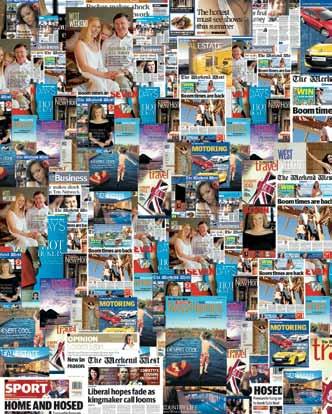



HMB Endeavour Around Australia 2011-2012 Voyage of a Lifetime PROUDLY SPONSORED BY C M Y CM MY CY CMY K history_endeavour_ad_FINAL.pdf 1 2/08/11 10:50 AM S I g NALS 97 D e C e MB e R 2011 T o F e BR u AR y 2012 21
Australian pirate tales
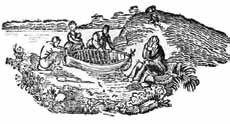
While there has been much serious study of the Australian colonies as places of crime and punishment, and much popular interest in Australian bushrangers, far less attention has been paid to maritime crimes. This article arose from a broader study of piracy in Australian history that curator Dr Stephen Gapps is researching for the redevelopment of the museum’s Commerce e xhibition.
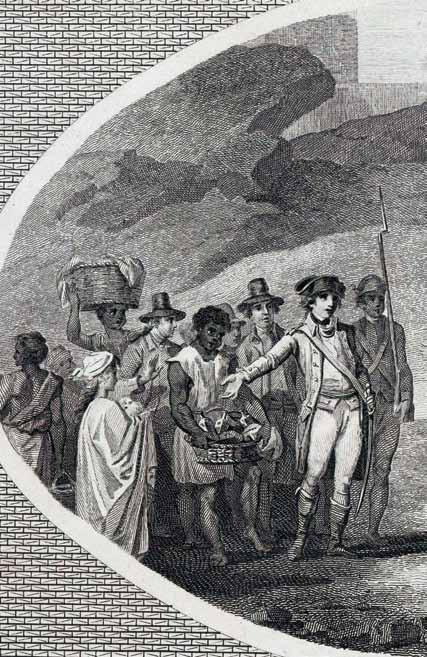
We might not think of Australian history as having much to do with pirates. Yet from the infamous Batavia mutiny in 1629 to the 1998 seizure of the oil tanker Petro Ranger by pirates in the South China Sea, there have in fact been dozens of instances of piracy in Australian waters or on vessels travelling from these shores. This article focuses on the 1790s to the 1840s – a period that might be considered the peak of piracy in Australia. During this half century the colonies were plagued by what were often described as ‘piratical seizures’ of vessels and ‘acts of piracy’. It wasn’t bushranging that was the most pressing law-and-order issue, but desperate convict escape attempts by sea on pirated vessels.
In 1806 the brig Venus was weatherbound for five weeks in Twofold Bay, on the south coast of New South Wales. Ill feeling had been building between its crew and Captain Chase who, fearing for his life, left to report to the authorities
that he also feared the crew would take the ship – which they promptly did. The Sydney Gazette described the ‘band of ruffians’. First mate Benjamin Kelly was a ‘pockmarked’ American whaler. Second mate Richard Edwards had a ‘very remarkable scar or cut in one cheek’. Seaman Joseph Redmonds was a ‘mulatto’ who wore his hair in pigtails and had ‘holes in his ears, being accustomed to wear large earrings’. Their accomplices included a ‘Malay cook’, two convicts with ‘sallow complexions’ and a woman with a ‘hoarse voice’. They would have been at home in any pirate tale.
Much of the history of piracy in Australian waters is muddied by details of definition. Petty criminals, mutineers,
S I g NALS 97 D e C e MB e R 2011 T o F e BR u AR y 2012 22
left: William Bligh and his company land on Timor in the Bounty longboat after the piratical seizure of the ship by mutineers. This epic open-boat voyage may have inspired hopes of escape by desperate Australian convicts in small pirated craft. engraving by William Bromley, publisher W & J Stratford 1791. ANMM Collection gift from Vaughan evans opposite: Cyprus castaways make a coracle for their rescue. Woodcut published in The Hobart Town Courier, 12 September 1829, attributed to W B gould. Archives office of Tasmania
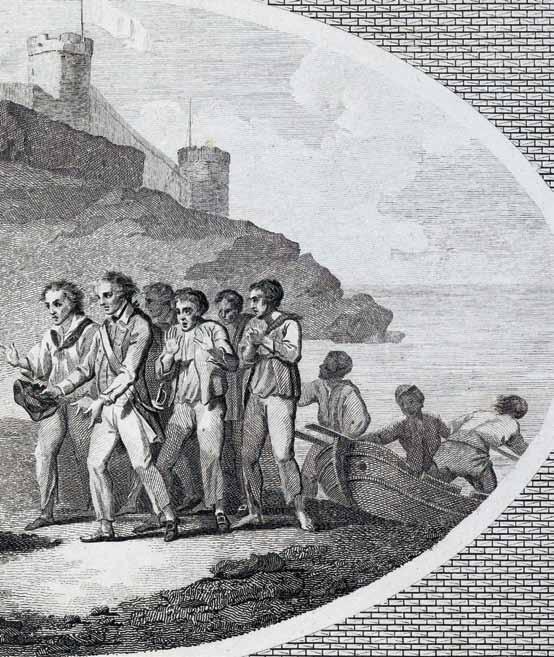
smugglers and thieves have often been labeled with some exaggeration as ‘pirates’. Others who had more right to wear the ‘pirate’ mantle were simply classed as escaped convicts. Yet many of the official and public descriptions of criminals who stole or seized ships from port or at sea – an accepted definition of piracy in the early 19th century -- correctly used the term ‘pirates’. Some Australian incidents had all the hallmarks of the Golden Age of Piracy (1650s to 1730s) with desperate criminals roaming the high seas in stolen ships.
The incredible voyage of Mary Bryant and her convict companions from Sydney to Timor in an open boat in 1791 showed that escape by boat from the colonies
was indeed possible. William Bligh’s epic open-boat voyage after the 1789 Bounty mutiny may also have inspired the many convict escape attempts that followed. Certainly, after the mutiny on the Bounty, ship captains in the Pacific were on their guard. The lure of stealing a ship and living in a tropical paradise in the South Seas was clear. Lieutenant George Tobin, on Bligh’s second breadfruit voyage in 1792, noted how ‘passing some months at a South Sea Island and in the full swing of indulgencies’ was good reason to keep a ‘vigilant eye upon the crew’.
‘Piratical seizure’ of ships became a major headache for colonial authorities, and strict harbour regulations were instituted. After the establishment
of Newcastle to Sydney’s north in 1804, ship security was critical. Vessel arrivals and departures required official sanction, and no one could leave a vessel without permission. Crews had to be on board their ships by 8.00 pm and sentries guarded the wharves. Despite these measures, many escapes were made from Newcastle. In 1804 convicts made off with Sergeant Day’s boat. In 1806 six convicts escaped on another unnamed boat. In 1814 the schooner Speedwell was taken by four ‘desperadoes’. The Newcastle pilot boat was taken in 1820 and the sloop Eclipse in 1825. None of these pirated vessels was ever heard of again.
In Sydney, too, strict port regulations were enforced due to regular attempts by convicts to seize vessels. In 1797 the government vessel Cumberland, regarded as ‘the largest and best ship in the colony’, was on a passage down the Hawkesbury River when it was taken over by some of the crew in a well-planned exercise that
S I g NALS 97 D e C e MB e R 2011 T o F e BR u AR y 2012 23
Although Sisters’ captain was reluctant to engage the pirated Wellington, his crew themselves opened fire on the imposters rather than see them sail away to freedom
included a boarding party from the shore. The so-called ‘pirates’ left three unwilling crew at Pittwater in Broken Bay and were never heard from again.
In 1800 the colonial sloop Norfolk was taken in a similar manner on the Hawkesbury River by 15 convicts. The escapees ran into foul weather and headed for safety in Coal River (now Newcastle’s Hunter River), only to run aground on the northern shore of the entrance. Six of the pirates went bush and were never found, while the others took to the ship’s boat and were later recaptured. The shipwreck site at modernday Stockton became known locally as Pirates Point.
During the early 1800s an average of one vessel was taken by pirates every year. In 1813 a vessel called Unity was ‘piratically seized’ by convicts while moored in the Derwent River off Hobart Town. Seven armed men crept aboard at night and cut the moorings, landing the crew in a small boat and then setting sail. In 1816 the brig Trial was ‘piratically seized’ in Sydney Harbour by a ‘banditti of villains’, mostly convicts employed in the stonemasons gang working on the Macquarie light tower, as well as two ‘natives of Portugal’. The construction site on high ground gave the convicts an ‘advantageous post of observation’ of harbour shipping and allowed them to target Trial, loaded with stores for Van Diemen’s Land.
A Government Notice in 1817 described the ‘Piratical seizure of the William Cossar’, a government vessel ‘cut from her moorings by some Pirates’. One was described as ‘a gypsy’ with ‘dark complexion, black eyes, black hair’ and the ‘fore finger of [his] right hand missing.’ But as the two-masted, 20-ton William Cossar had neither decks nor anchor, it was presumed by the Sydney Gazette that its ‘destruction was inevitable’. In fact neither it nor Unity were ever seen again. The wreck of the Trial was later discovered at South West Rocks, but none of the convict escapees were found.
If there was ever a scourge of piracy in Australian history, it was in Tasmania during the 1820s to 1850s, when Van Diemen’s Land was the repository of the largest number, and many of the most hardened and desperate, of convicts in the colonies. ‘Piratical seizure’ was so prevalent that there was a standing Port Order to Derwent shipping that ‘when moored… sails must be taken off the spars and the ship’s rudder taken ashore’. Unfortunately for the owner of the
schooner Young Lachlan on the night of 27 February 1819, the master had failed to do this – perhaps feeling safe that the vessel was abreast his residence on the banks of the Derwent. The ship was boarded at dawn by 13 convicts who stole out of the harbour and then marooned the crew on Bruny Island. Young Lachlan had been provisioned but had not yet taken on water, causing the pirates ‘extreme sufferings’. However, they managed to reach Java where their efforts to sell the vessel were unsuccessful, since they could provide no papers to the Dutch officials.
Quickly changing plans, the men burned the schooner and continued their journey in the ship’s boat. Things turned from bad to worse at their next port of call when they tried the too-well-worn tactic of pretending to be shipwreck survivors. The skeptical Dutch authorities threw them into gaol, where most died ‘of fever’. Five were eventually returned to Hobart, tried and duly hanged for ‘cutting out and stealing goods’.
Perhaps one reason that piracy has not been more prominent in Australian maritime histories is that the vast majority of attempts to escape by pirating a ship were failures. Nonetheless, many of the stories are quite remarkable. For example, the piratical seizure of the brig Wellington en route to Norfolk Island in 1827 by prisoners, among whom was the aptly named ‘Flash Jack’ Edwards, led to a sea battle of sorts. After divesting the ship’s company of soldiers of their ‘accoutrements and red coats, in which the pirates became dressed’, they made for New Zealand with the ultimate goal of reaching South America.
Entering the Bay of Islands, Wellington came upon two vessels, Sisters and Harriet, whose captains detected the ruse since the escapees ‘had no appearance whatever of regular troops.’
Although Sisters’ captain was reluctant to engage the pirated Wellington, his crew themselves opened fire on the imposters rather than see them sail away to freedom. Wellington’s decks were soon cleared – not for action, but by pirates diving overboard or running below. Wellington failed to fire a shot in return and the Sisters took the brig under guard back to Sydney Cove.
In the Australian colonies the term ‘pirate’ was selectively applied, often to highlight particularly bold or bloody crimes at sea. The so-called ‘pirates of the brig Cyprus’ were a case in point. In August 1829 Cyprus was transporting a group of convicts from Hobart to Macquarie Harbour when it was storm-
S I g NALS 97 D e C e MB e R 2011 T o F e BR u AR y 2012 24
bound in Recherche Bay. The convicts took over the ship, which was stocked with provisions, and marooned 44 soldiers, sailors and convicts who chose not to join them. These included 15 ‘trusty’ convicts, some of whom used a knife and a razor to build a coracle of canvas stretched over pliable wattle sticks and waterproofed with beeswax and soap. It proved seaworthy and all were rescued.
The 18 men who sailed away for the Pacific islands were led by a former sailor and rather experienced pirate, William Walker, alias William Swallow. Walker had been sentenced twice to transportation. The first time he escaped on a vessel and made his way back to England, only to be caught stealing again and tried a second time as William Swallow. Swallow must have cut something of a figure; he was described as tall with striking blue eyes and ‘a long nose and prominent fleshy chin, both bearing small scars’.
The pirates set about renaming and repainting the vessel. They cut off the figurehead and forged a set of ship’s papers and a false log of a voyage from Manila to South America. In a remarkable feat of navigation with no experienced crew, ‘Captain’ Swallow sailed the Cyprus to New Zealand, the Chatham Islands, north-east to Tahiti and then to Tonga. The crew were divided about where best to escape the authorities – in the Friendly Isles of Tonga or further away from New South Wales, in China or Japan. Captain Swallow favoured Tonga but the ‘China faction’ prevailed, leaving seven of the ‘Tonga faction’ on Niue Island but forcing Swallow to join them as navigator. As he later wrote, ‘They imprisoned me in the Cabin and kept me eight hours there when they ordered me to come upon Deck and Steer the Ship to Japan’.
The pirates probably had no knowledge of Japan’s self-imposed isolation and hostility towards foreigners. When Cyprus arrived off Yokohama with tattered sails and a crew desperate for water, they were met by a hail of musket and cannon shot. One passed so close to Swallow it knocked a telescope from his hands. A fortunate breeze sprang up and the pirates fled for China. Swallow still entertained thoughts of the Pacific Islands but dissenting crew holed the vessel and paid a passing Chinese junk in pieces of eight to take them to land. Swallow and three remaining crewmen tried unsuccessfully to fother the vessel, then took to the longboat and presented themselves ashore as shipwreck survivors.
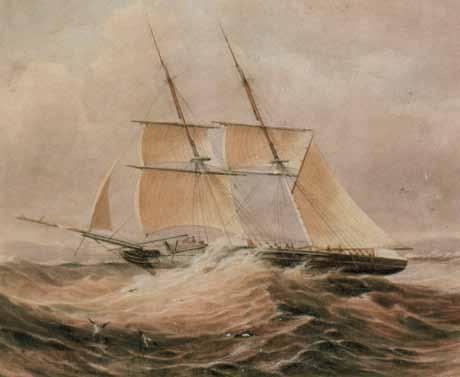

top: originally built for the slave trade, this vessel bears the compact brig rig, well-suited for handling by smaller crews. The brig Scout/ Capt. Condell/ beating out of Encounter Bay June 11th 1840 by Frederick garling, watercolour 1840. ANMM Collection
above: Hobart on the Derwent estuary, Tasmania, the scene of numerous earlier ‘piratical seizures’ of ships by convicts desperate to flee their harsh servitude. Hobart Town 1856, oil on canvas by Henry gritten. ANMM Collection
S I g NALS 97 D e C e MB e R 2011 T o F e BR u AR y 2012 25
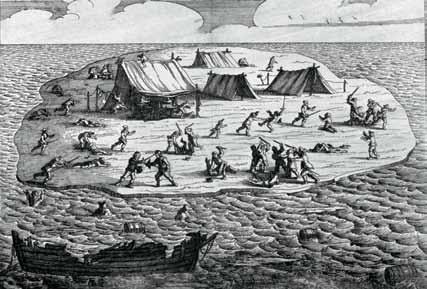
This cover story worked and they obtained passage as crew on a vessel returning to London. However their ruse came undone when their former shipmates turned up with the same story, but with contradictory facts. It must have been sorely disappointing, after such an epic journey, to be taken straight to prison when they landed in London. The magistrates had little evidence to go on, but by a strange quirk one of the ‘trusty’ convicts who had made the coracle in Recherche Bay – and thereby earned his freedom – was in London at the time. So too was the Hobart Town gaoler, and the pirates were all recognised.
The pirates of the brig Cyprus caused a great public stir and the Old Bailey was crowded for what would be England’s last-ever trial for the crime of piracy. Swallow and two others were sentenced for life and transported back to Hobart, arriving at Macquarie Harbour prison two years later than originally intended. For Swallow, it was his third voyage of transportation. Two men were hanged at Execution Dock, the last to be executed in England for piracy. The tale of Captain Swallow and the pirates of the brig Cyprus had captured public imagination and was dramatised as a play in London theatres. Swallow himself died of consumption in Port Arthur in 1833 and was buried in an unmarked grave on the Isle of the Dead.
Some convict escapees did manage to gain a period of freedom in foreign lands, but the long arm of the British Empire was ever-present. In one famous instance in 1834 the brig Frederick was seized by convicts in Macquarie Harbour, Van Diemen’s Land, and sailed to South America where the Governor of Valparaiso in Chile was taken by their honesty and their abilities as shipwrights.
He promised them protection and the opportunity to live and marry in Chile. Some of the men settled well, but a group built a whaleboat – ostensibly for the governor – and then set sail. His trust abused, the governor threw the rest of the escapees in gaol until an English vessel called and took them back to Britain. They were sent back to Hobart to stand trial for the ‘piratical seizure of the Brig Frederick’.
If Australia had its own version of desperate, unruly, Pirates of the Caribbean islands beyond the reach of law, it was the windswept islands of Bass Strait. Surrounded by treacherous waters where wreckage drifting ashore was commonplace, here lived the so-called Straitsmen. They were often convict escapees or brutalised ex-convicts who had no interest in returning to the civilized world, preferring to take an Aboriginal wife and survive on bush tucker and the meager livelihood provided by seal skins and mutton birds. The historian John Cumpston described them as ‘a complete set of pirates’.
Some Straitsmen were reportedly convicts who had managed to escape by sea, but were shipwrecked or left stranded by their fellow fugitives. Many lived well beyond the rule of law, trying to lure passing ships onto the rocky islands with lights. There were shadowy rumours that shipwreck survivors were murdered by Straitsmen desperate for plunder.
Perhaps the most famous tale – or at least one with some corroboration by witnesses – concerned the mysterious disappearance of the barque Britomart in 1839. In search of the overdue vessel, Captain Gill of Sir John Franklin landed on Preservation Island where none of
Certainly, after the mutiny on the Bounty, ship captains in the Pacific were on their guard. The lure of stealing a ship and living in a tropical paradise in the South Seas was clear
the residents admitted any knowledge of Britomart. Gill became suspicious when he spied a ‘part of a ship’s cabin being used as a pig sty.’ The pig sty owner, Mr Munro, also had books and papers belonging to the captain of the Britomart. The Port Phillip Herald then reported that several ‘sealers from Bass Strait… made their appearance in Launceston’ not long after the vessel disappeared and had ‘more money than persons following their avocation were likely to have become honestly possessed of, and one of them is said to have publicly stated that he knew where the wreck of the Britomart was to be found and would point it out if properly remunerated’. The suspicion was that the Britomart had been plundered and the survivors had been massacred.
Authorities were urged to investigate, but the mystery was never solved.
Australian history abounds with tales of robbery under arms, of bushrangers and bandits. It is not nearly so wellknown for piracy, despite a number of published accounts that were consulted during this research. Yet the importance of safe and secure shipping lanes was critical to the early colony. The study of piracy – particularly in the early years of the colony – warrants further investigation. There might not be a maritime equivalent to Ned Kelly or Ben Hall, but there are indeed some Australian pirate tales well worth the telling.
above: Maritime mayhem in Australian waters as the mutineers of the Batavia shipwreck murder shipmates and passengers. The would-be pirates planned to capture a rescuing ship and flee the scene of their crimes. engraving from Ongeluckige Voyagie van’t Schip Batavia, nae de OostIndien (unlucky voyage of the Batavia…), Jansz, Amsterdam, 1647. ANMM Collection
S I g NALS 97 D e C e MB e R 2011 T o F e BR u AR y 2012 26
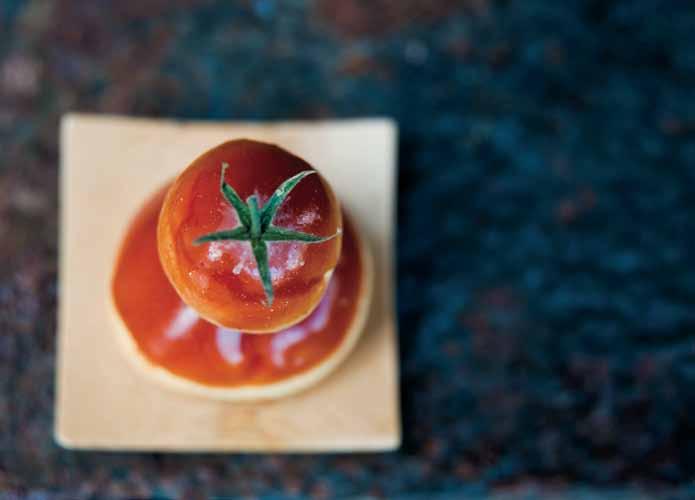
After renovations, Yots and the Ben Lexcen Terrace are open again for venue bookings – revitalised on the inside with the same fantastic views outside.
For formal dinners, stylish cocktail parties and memorable product launches, your guests will be delighted by our magnificent waterfront venues overlooking the historic fleet.
Award-winning Laissez-faire Catering offers flexible and exclusive menus. Book now for Christmas by the water.
T: +61 2 9298 3625 venues@anmm.gov.au www.anmm.gov.au/venues

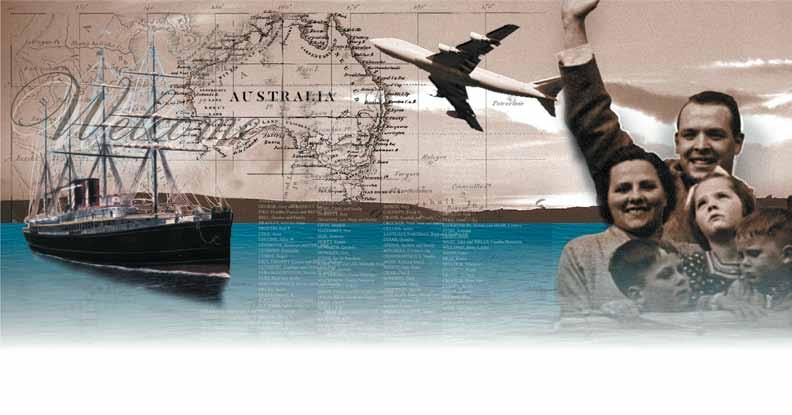
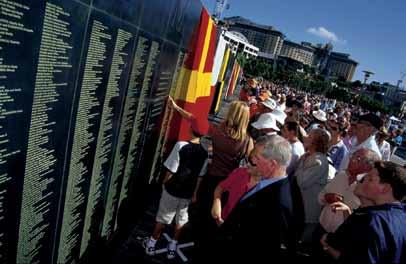
More than six million people have crossed the world to settle in Australia. Was your family among them?


To honour our unique heritage, the National Maritime Museum has created the Welcome Wall to record your name in bronze and your stories for future generations. The Welcome Wall honours our immigrants, however they travelled, wherever they landed and wherever they live today.
An ideal tribute to loved ones that will last forever.
Call 02 9298 3777 or visit www.anmm.gov.au/ww to register your name today.
NMM943_SIG2 new venue new menu
S I g NALS 97 D e C e MB e R 2011 T o F e BR u AR y 2012 27

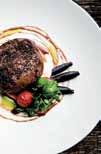

Enjoy your wedding ceremony or reception at our unique waterfront setting. Located on the western shore of Darling Harbour, the venues have splendid city skyline and harbour views.
Enjoy pre-dinner drinks on the decks of the HMAS Vampire before moving into the glassed Terrace Room.

Laissez-faire Catering, renowned for their innovative cuisine, along with delivering service of the highest standard, are the venue’s exclusive caterers.
T +61 2 9298 3625 venues@anmm.gov.au www.anmm.gov.au/weddings


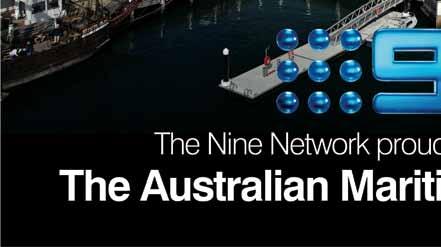
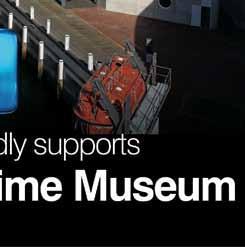
Photos: bottom Blumenthal Photography; top Wyatt Song, Moments in Time S I g NALS 97 D e C e MB e R 2011 T o F e BR u AR y 2012 28
program
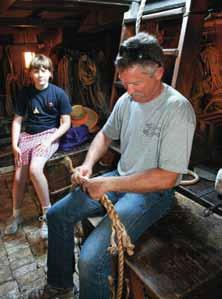
even better value for members
Thank you to all our valued Members for your continued support for our program throughout this year that’s seen lots of developments and changes. After 12 months of hoardings and construction, our new visitor facilities are coming on line. I know Members will welcome the return of Yots Café which, as you read this, will have re-opened for full-menu service. With summer upon us you will enjoy lunching once again with friends on our delightful harbourside boardwalk.
There is another big change taking place that will have the effect of making your valued Membership of the museum even more valuable. From 2 December the museum is re-introducing entry fees for our galleries and exhibition … but not for Members! you will continue to have FRee entry to the museum, as often as you like. That includes free entry to our big Navy vessels, the destroyer Vampire and submarine onslow, and to the historic replicas Duyfken and Endeavour when she returns from voyaging next May.

our 20th-anniversary Foundation Members cocktail party on 17 November: special guest Minister for the Arts Simon Crean with director Mary-Louise Williams; acting Members manager Claire Palmer and chairman Peter Dexter; Foundation Members including Sir James Hardy, Halcyon evans, Wendy Hardiman. Photo J Mellefont/ANMM
Which makes a gift Membership an even better Christmas or birthday present for your friends or family. Sharing your museum – including its lively events program and quarterly colour journal Signals – makes a great gift for that loved one who’s got
everything or is difficult to buy for. A gift Membership lasts all year.
This summer get ready for the international attraction AQUA: A journey into the world of water, a multisensory experience developed by Cirque du Soleil® and oNe DRoP opening on 3 December. It’s an interactive and visual spectacle that carries a powerful message about water as a vital resource for our planet. Check out the following program pages for details of the special Members preview and other AQuA-related events.
With summer upon us, there’s a range of great festivities on the water. They include the start of the Sydney–Hobart yacht race, a cruise on Lady Hopetoun, and the excitement of ferry races and tall ships on Australia Day on Sydney Harbour. you may have read of director MaryLouise Williams’ imminent retirement. Her replacement hasn’t yet been announced, but in December there will be a new Members Manager, Kathy Baykitch, to look after you. It’s time for me to move on to other challenges, too. I have enjoyed meeting you, our Members, and had some really memorable times with you on our various activities and outings. Wishing you all the very best for the future!
Claire Palmer, acting Members manager

Members
News
A Members
for teens featured lessons in traditional seamanship on board the replica of Dutch scout ship Duyfken that made the first recorded european landing in Australia (1606). Photographer Claire Palmer
Below: Former master of Duyfken, gary Wilson; author Ian Burnet (centre) whose book Spice Islands is reviewed on page 56; museum curator of exploration and european settlement, Dr Nigel erskine (right). Photographer Clare Power
S I g NALS 97 D e C e MB e R 2011 T o F e BR u AR y 2012 29
Members events
Calendar Summer 2011/12
Friday 2 Preview: AQuA: A Journey into the World of Water
Tuesday 13 On the water: MB 172
Wednesday 14 Special: AQuA – a precious resource with Tim Costello
Thursday 15 Special: Dutch yuletide and champagne shopping night
Sunday 18 Talk & tour: Research vessel Whale Song
Monday 26 On the water: Sydney–Hobart race-start cruise January
Saturday 7 For kids: AQuA, pizza and pyjama night
Friday 13 For teens: Seamanship skills & 17th-century sailing
Friday 20 For kids: Fishing 4 Kids
Sunday 22 Talk: Dead Man’s Silver with Hugh edwards
Thursday 26 Australia Day: Luxury ferry cruise on MV Princess, Family ferry cruise on MV Regal, Family fireworks & Byo picnic
February
Thursday 9 Silent film: Buster Keaton on water
Sunday 12 Book launch: Submarine Six with Dr Tom Lewis
February 14 On the water: Valentines Day cruise on Lady Hopetoun
Sunday 26 Day tour: AQuA Hunter Valley sustainable agriculture tour March
Thursday 8 Lecture: 10th Phil
How to book
It’s easy to book for these Members events… have your credit card details handy:
• book online at www.anmm.gov.au/ membersevents
• phone (02) 9298 3644 (business hours) or email members@anmm.gov.au Bookings strictly in order of receipt
• if paying by mail after making a reservation, please include a completed booking form (on reverse of your Signals mail-out address sheet) with a cheque made out to the Australian National Maritime Museum
• if payment is not received 7 days before the event your booking may be cancelled
Booked out?
We always try to repeat the event.
Cancellations
If you can’t attend a booked event, please notify us at least five days before the function for a refund. otherwise, we regret a refund cannot be made. events and dates are correct at the time of printing but these may change…if so, we’ll be sure to inform you.
Parking
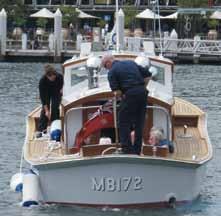
Members preview AQUA: A Journey into the World of Water
6–7 pm Friday 2 December at the museum
Join us for an exclusive Members preview of AQUA: A Journey into the World of Water with technical director Martin Fassier. Discover the story of water and its importance for the planet in this multisensory experience featuring water installations, 360°screen projections and visual effects.
Members $15, general $20. Includes light refreshments and Coral Sea Wines
on the water MB 172
12 noon–1.30 pm Tuesday 13 December on the harbour
MB 172 is an elegant timber naval motor launch that once carried naval officers and VIPs. Built by the RAN at garden Island Naval Dockyard in 1937, it spent most of its working life in Darwin. Join ANMM fleet manager Phil McKendrick and shipwright Jeff Hodgson for an illustrated talk about the launch’s recent restoration over a light lunch, then step aboard for a 20-minute motor in the Darling Harbour precinct.
Members $20, general $30. Includes light lunch and refreshments. Strictly limited places
December
Renouf Memorial Lecture
Wilson Parking offers Members discount parking at Harbourside Carpark, Murray Street, Darling Harbour. you must have your ticket validated at the museum ticket desk.
S I g NALS 97 D e C e MB e R 2011 T o F e BR u AR y 2012 30
ex-RAN officers’ motor launch MB 172 left: ANMM photograph
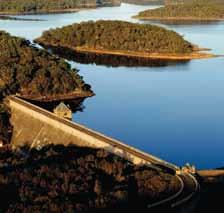
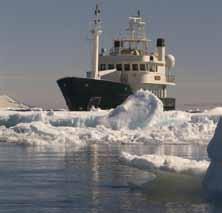
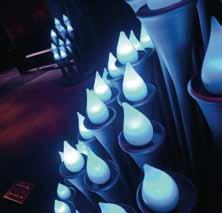
Special AQUA – a precious resource with Tim Costello
6.15–8.30 pm Wednesday 14 December at the museum
AQUA: A Journey into the World of Water is a visual spectacle, with a powerful message: it reminds us that water is a vital resource for our planet. In Australia, we take fresh tap water for granted, but others are not so lucky. AQuA transports us around the globe to places where water is in short supply or seriously polluted. Tim Costello from World Vision talks about the importance of clean water projects in developing countries and Sarah Dinning from Sydney Catchment Authority discusses our drinking water and the health of catchment areas around Sydney.
Members $45, general 55. Includes reception and Coral Sea Wines, plus a viewing of AQuA
Special Dutch Yuletide and champagne shopping night
5.30–7.30 pm Thursday 15 December at the museum
Kick off the Christmas celebrations for the whole family with the Dutch tradition of Pakjesavond (‘present evening’) alongside visiting Dutch jacht Duyfken. Put on your clogs and join in all the festivities with a Dutch choir, folk-dancing group and a special appearance by Sinterklaas (the Dutch St Nicholas). Includes a complimentary glass of champagne and a 20% discount at The Store for those last-minute gifts. The evening will conclude with speculaas (traditional Dutch biscuits) and a hot chocolate on board Duyfken.
Members $20, general $25. The museum will stay open late for you to wander.
Talk & tour
Reseach vessel Whale Song
1 pm–2.30 pm
Sunday 18 December at the museum
RV Whale Song is a modified 13.25-metre Simpson design. It is operated by the Centre for Whale Research (Western Australia) Inc., a non-profit institute established in 1993 to conduct scientific research into marine mammals in the order Cetacea, the whales, dolphins and porpoises. Join Curt and Mitch Jenner for a talk about their recent research on the behavioural impact on humpback whales of seismic guns used in mining exploration, followed by an inspection of the vessel.
Members $20, general $25. Includes reception with Coral Sea wines and an inspection of the vessel at our wharves.
on the water
Sydney–Hobart race-start cruise
11 am–2.30 pm Monday 26 December on Sydney Harbour
Farewell this year’s Sydney–Hobart yacht fleet this Boxing Day on board luxury ferry MV Bennelong. Take in all the colour, excitement and salt-spray of our harbour’s most spectacular blue-ribbon day. Picnic on your leftover Christmas dinner as we follow the fleet to the heads. Members: adult $65, child $30. general: adult $75, child $40. Byo picnic. Cash bar on board. Meet next to HMAS Vampire
For kids
AQUA, pizza and pyjama night
5.30–9 pm Saturday 7 January at the museum
Take a well-earned night off while the kids tour HMAS Vampire and the visiting vessel Duyfken with long-time museum caretaker Spanka Boom, who will lead them into the magical world of AQuA! There’ll be funny stories, songs and activities along the way, and a pizza dinner. Then the kids can roll out a sleeping-bag, grab a pillow and lie back to watch the fabulous family movie Ice Age on the big screen, complete with a choc-top ice-cream!
Member child $25, general $35. Includes pizza, refreshments, movie and craft activities. Bring a torch, pillow and sleeping-bag. Children will be fully supervised (parents/carers not required to stay). Ages 5–12
For teens
Seamanship skills & 17th–century sailing
4.30–8 pm Friday 13 January at the museum
Come aboard the 17th-century jacht Duyfken, a reconstruction of explorer Willem Janszoon’s Dutch e ast India Company vessel, and learn about life aboard a square-rigged ship with shipkeepers Mirjam Hilgeman and Andrew Bibby. Learn the basics of seamanship, including rigging, knotting, splicing, watch-keeping, taking the helm and even cooking in the galley with historic culinary expert Louise Lathouwers. Members $55, general $65 (strictly limited places). Includes dinner and a one-hour culinary skills talk. Ages 12+
right: Courtesy Sydney Catchment Authority centre: Centre for Whale Research far right: Courtesy of o ne Drop, an initiative of g uy Laliberté
Cataract Dam, New South Wales
AQuA: A Journey into the World of Water
S I g NALS 97 D e C e MB e R 2011 T o F e BR u AR y 2012 31
Research vessel Whale Song
Members events

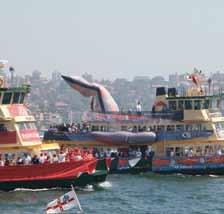

For kids
Fishing 4 Kids
10 am–12 noon OR 11 am–1 pm Friday 20 January at the museum wharves
This workshop teaches children responsible fishing practices and includes a segment on sharks and sustainability. Learn about conservation of fish habitats, sustainable fishing, knot-tying, line-rigging and baiting, casting techniques and handling fish. Find out about the fish that live in and around Darling Harbour – and what they eat. e ach child receives a prize and fishing tackle to take home, plus a certificate of achievement.
Members $25, general $30. Ages 5–12 years. Includes morning tea and refreshments. Children will be fully supervised by RFT education officers
Talk
Dead Man’s Silver with Hugh Edwards
2–3.30 pm Sunday 22 January at the museum
Hugh edwards has been associated with the recovery of four treasure ships. Acknowledged as the ‘primary finder’ of the wreck of the Batavia, he takes a close look at this and other Dutch e ast India Company wrecks found off the coast of Western Australia. His other ventures include recovering the ship’s bell from William Dampier’s vessel Roebuck of 1701, being ambushed by Pol Pot in Cambodia, diving to the shell-battered wreck of the 1914 g erman cruiser Emden in the Indian ocean, and salvaging porcelain from the great Chinese junk Tek Sing, which struck a reef in the South China Sea off Sumatra in 1822 with the loss of 1,750 lives.
Members $20, general $25. Includes light refreshments and Coral Sea Wines
Australia Day
Luxury ferry cruise on MV Princess
10.30 am–2.30 pm Thursday 26 January on Sydney Harbour
BOOKINGS AND ENQUIRIES
Booking form on reverse of mailing address sheet. Please note that booking is essential: online at anmm.gov.au/membersevents or phone (02) 9298 3644 (unless otherwise indicated) or email members@anmm.gov.au before sending form with payment. All details are correct at time of publication but subject to change.
enjoy Australia Day harbour festivities on MV Princess get stirred up in the wash of the famous Ferrython, the spectator fleet, Navy and Air Force flyovers, and lots more.
Members: adult $65, child $30, family of 4 $130. g eneral: adult $75, child $45, family of 4 $160. Byo picnic, cash bar on board. Meet next to HMAS Vampire
Australia Day
Family ferry cruise on MV Regal 10.30 am–2 pm Thursday 26 January on the harbour
Take in all the on-water activity of Australia Day with this shorter kids-friendly cruise on MV Regal. See the famous Ferrython, the historic fleet, Navy and Air Force flyovers, with onboard entertainment for the kids.
Members: adult $60, child $35, family of 4 $140. g eneral: adult $70, child $50, family of 4 $170. Byo picnic. Meet next to HMAS Vampire
Australia Day
Family fireworks & BYO picnic
7–10 pm Thursday 26 January museum forecourt and Vampire decks
Celebrate Australia’s national day and watch the magnificent Darling Harbour fireworks at our family-friendly location, with entertainment by our roving jazz band. View the 9 pm Cockle Bay fireworks from the museum forecourt or the decks of Vampire. Byo picnic and we’ll provide chairs, face-painting – and a great view! Rain, hail or moonshine.
Members: adults $20, child (16 & under) $15, family of 4 $50. g eneral: adults $25, child $20, family of 4 $65. Snacks, coffee and refreshments on sale
this page: ANMM photographs
Fishing 4 Kids at our wharves
Australia Day Ferrython
S I g NALS 97 D e C e MB e R 2011 T o F e BR u AR y 2012 32
Australia Day fireworks alongside Vampire

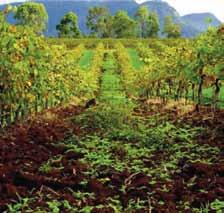

Silent Film
Buster Keaton on water
6.15–9 pm Thursday 9 February at the museum
Set in cabaret-style along the harbour’s edge, enjoy a performance by pianist Mauro Colombis themed on water in conjunction with our summer attraction
AQUA: A Journey into the World of Water
Laugh yourself silly and enjoy a two-course dinner as Mauro accompanies snippets from silent nautical films from the Buster Keaton Collection. Held in conjunction with National Film and Sound Archive.Includes a free viewing of AQuA.
Members $45, general $55. With dinner package (main, dessert and Coral Sea. Wines by Laissez-Fare catering): Members $85, general $95. Includes AQuA viewing
Book launch
Submarine Six: Australian Naval Heroes with Dr Tom Lewis
1–4.30 pm Sunday 12 February at the museum
In the 1990s the Royal Australian Navy broke with tradition and named six Collins Class submarines after six Australian naval heroes: HMAS Collins, HMAS Farncomb, HMAS Waller, HMAS Dechaineux, HMAS Sheean and HMAS Rankin
Captain Hector Waller DSo, Seaman Teddy Sheean, and Lieutenant-Commander Robert William ‘oscar’ Rankin are currently being considered for retrospective honours. All six men served their country with great distinction and Tom Lewis highlights their achievements in his latest book Submarine Six
Members $25, guests $35. Includes Coral Sea wines and cheese
on the water
Valentine's Day cruise on Lady Hopetoun
10–11.30 am OR 12 noon–1.30 pm Tuesday 14 February on the harbour
Named after the wife of the First governorgeneral of Australia, the Lady Hopetoun was built in Berry's Bay and launched on 10 April 1902. She served as NSW government’s VIP launch for many years, and is now owned and operated by Sydney Heritage Fleet. Don’t miss your chance to take a short cruise on this classic vessel and hear about her fascinating history and restoration from SHF representatives. Members $50 general $60 (limited places available). Includes refreshments on board. Meet on the Performance Platform
Hunter Valley day tour
AQUA sustainable agriculture tour
7 am–7 pm Sunday 26 February at the Hunter Valley
Spoil yourself on a sustainable wine and food tasting tour of the Hunter Valley. Travel through beautiful countryside, learn about the responsible use of water and environmentally friendly agricultural techniques, and savour the flavours of organic farming. Includes a behind-thescenes guided tour at one of the Hunter Valley's finest boutique wineries. Taste some delicious cheeses and local produce before returning to Sydney.
Members $110, general $120. Includes return trip by luxury coach and lunch
Lecture
10th Phil Renouf Memorial Lecture 6.15–8.30 pm Thursday 8 March at the museum
The museum and Sydney Heritage Fleet join forces again to present this annual lecture in honour of the late president of SHF, Phil Renouf. This year’s speaker will be Commodore Kim Pitt oAM RAN (RTD), who will talk about his incredible career. He served for 32 years as an officer in the RAN, as a submariner and in intelligence and logistics, rising to the position of Chief of Staff, Support Command (Navy). In his ‘second life’ he worked for Australia’s Antarctic program, visiting all our Antarctic stations and bases as well as those of ten other countries. During this time Kim served two terms as chair of the Standing Committee of Antarctic Logistics, an international group representing the 29 nations that operate in Antarctica. ANMM and SHF members $20, guests $25. Includes Coral Sea wines and cheese
EMAIL BULLETINS
Have you subscribed to our email bulletins yet? Email your address to members@anmm.gov.au to ensure that you’ll always be advised of activities organised at short notice in response to special opportunities.
right: John Allcot (1888–1973), ANMM Collection far right: Photographer David Lovett
Hunter Valley wine tour
Past SHF president Phil Renouf
S I g NALS 97 D e C e MB e R 2011 T o F e BR u AR y 2012 33
Heritage vessel Lady Hopetoun
AQUA: A Journey into the World of Water
3 December 2011–26 February 2012
Immerse yourself! Discover the story of water in this unique multisensory experience for the whole family. go on a guided round-the-world journey featuring water installations, visual effects and 360° screen projections. Make a pledge to save and protect water for the planet!
Created by oNe DRoP, an initiative of guy Laliberté, Founder of Cirque du Soleil® oNe DRoP fights poverty worldwide by supporting access to safe water and raises awareness of water-related issues. Visit oNeDRoP.org
entry to AQuA via Big Ticket only. Sessions every 30 minutes from 10 am. Places allocated at time of purchase only and subject to availability.
20 years – a snapshot
Until 4 March 2012
Celebrate the museum’s 20th anniversary with us! Come and see photographs of some of the highlights of the past 20 years – from royalty and rock stars to vessels and Vikings, from behind-the-scenes glimpses to the blockbuster shows.
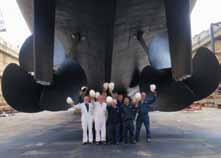






20 years – Museum Moments photography competition
Share your museum moments in our 20th-anniversary photography competition. Submit images past and present online for your chance to win great prizes, including a $4,000 digital SLR for best photograph. Delve into your archives or start snapping today! Selected photos will be featured in a coming issue of Signals
For details on how to enter visit www.anmm. gov.au/20years (entries close 14 February)
Australia Day celebrations!
Thursday 26 January
Celebrate Australia Day at the museum with free entertainment and activities for all the family plus special free entry to the museum’s galleries & e xhibitions (excluding AQuA).

Duyfken
This summer explore our visiting replica vessel Duyfken while HMB Endeavour is at sea. The Dutch e ast India Company ship Duyfken (‘Little Dove’) made the first recorded european visit to the Australian continent in April 1606, landing on the west coast of Cape york Peninsula. Its captain Willem Janszoon made the first chart of mainland Australia.
Tour of the ship included in the Big Ticket. Members FRee
ADMISSION
Refund of your entry fees if you become a Member during your visit!
Galleries & Exhibitions Ticket (excluding AQUA)
Adult $7
Child (4–15 years)/Concession $3.50
Family (2 adults + 3 children) $17.50
Members/Australian pensioners/ Children under 4 FREE
Big Ticket
(Galleries & Exhibitions + Vessels + Kids on Deck + AQUA)
Adult $25
Child (4–15 years)/Concession/ Pensioners $10
Family (2 adults + 3 children) $60
Members/Children under 4 FREE
Group bookings (10 or more people) 20% discount on ticket prices
FREE ENTRY to Galleries & Exhibitions (excluding AQUA) on the FIRST THURSDAY of the month (excluding public and school holidays)
AQUA_panel_bleeds_B.indd 1 14/11/11 11:10 AM exhibitions
left: Duyfken
Replica 1606 Foundation centre: ANMM photograph
Visiting vessel Duyfken replica
Destroyer Vampire in dry dock July 2010
S I g NALS 97 D e C e MB e R 2011 T o F e BR u AR y 2012 34


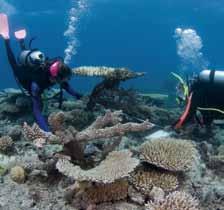
Barque James Craig
Sydney Heritage Fleet’s magnificent 1874 iron-hulled barque James Craig was recommissioned in 2000 after an awardwinning, 30-year restoration – one of only four such vessels in the world that are still sailing.
Joint ticketing with the Sydney Heritage Fleet. The ship sails alternate Saturdays and Sundays. Check www.shf.org.au for details
HMB Endeavour circumnavigation
HMB Endeavour replica’s epic circumnavigation of Australia has reached its halfway point, with the ship arriving in Fremantle to a huge welcome. Endeavour will be the special ‘celebrity visitor’ for Perth’s 2011 ISAF Sailing World Championships and from 3–13 December will be taking visitors on day sails. For more information visit: http://www.perth2011.com/ Follow the voyage on www.endeavourvoyages.com.au
Visit Endeavour this summer in these ports: 14–18 January: Albany Waterfront Marina 4– 8 February: Port Lincoln 16–23 February: Port Adelaide


ANMM travelling exhibitions
On their own –Britain’s child migrants
Until 6 May 2012
Immigration Museum, Museum Victoria
From the 1860s until the 1970s, more than 100,000 British children were sent to Australia, Canada and other Commonwealth countries through child migration schemes. The lives of these children changed dramatically and fortunes varied. Some forged new futures; others suffered lonely, brutal childhoods. All experienced dislocation and separation from family and homeland.
A collaboration between the ANMM and National Museums Liverpool, uK

Freshwater Saltwater – Aboriginal and Torres Strait Islander prints
17 December 2011–29 January 2012
Burnie Regional Art Gallery Tasmania 18 February–15 April 2012
Geelong Gallery Victoria
Prints from the museum’s collection commemorate the rich living relationship between Indigenous people and water. Vivid representations of marine life and environments celebrate the survival of these communities and their struggle for justice and land and sea rights.

Wrecks, reefs and the Mermaid
Until 12 February 2012
National Wool Museum Geelong Victoria 18 February–20 May 2012
Eden Killer Whale Museum NSW
Photographs by Xanthe Rivett illustrate the museum’s work during two archaeological expeditions to remote coral reefs off the coast of Queensland, supported generously by the Silentworld foundation.


below right: Reproduced courtesy artist and Buku-Larrnggay Mulka Centre centre: Reproduced courtesy Sydney Lee far right: photographer Xa nthe Rivett 2009
exhibitions
Baru (Crocodile) by Nancy gaymala yunupingu 2005
Divers and the Mermaid anchor
1874 tall ship James Craig, Sydney Heritage Fleet Child migrant Stewart Lee, 1955
S I g NALS 97 D e C e MB e R 2011 T o F e BR u AR y 2012 35
A Journey into the world of wAter
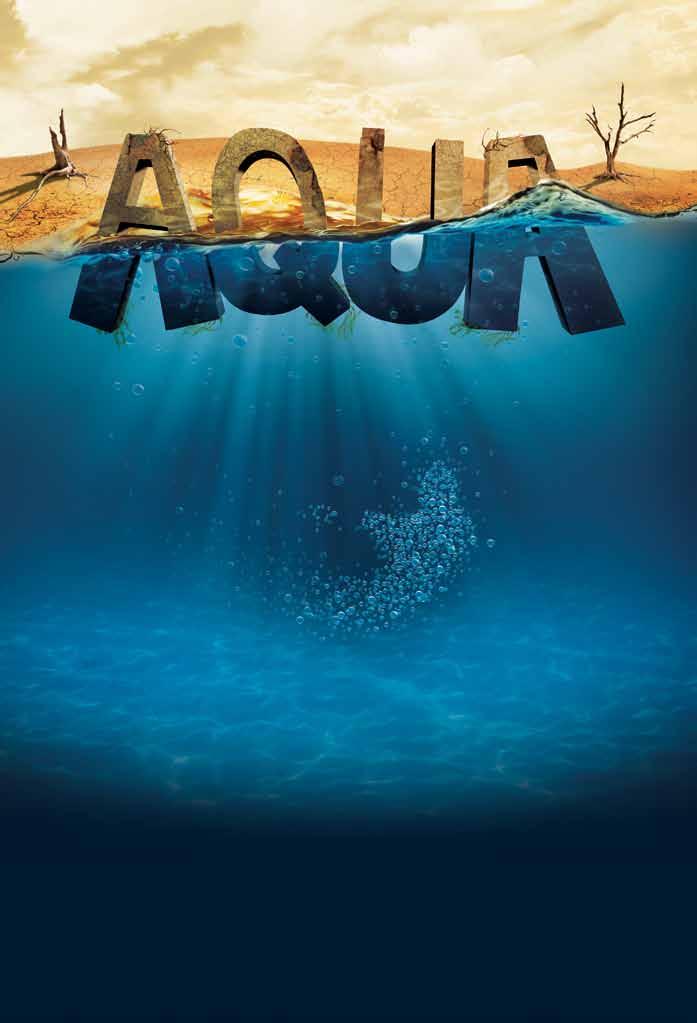
Discover the story of water and its importance in our lives as you are taken through a journey of water installations and visual effects. Be immersed in an adventure around the world, in which you are both participant and spectator, surrounded by 360º screen projections. AQUA is created by ONE DROP – an initiative of Guy Laliberté, Founder of Cirque du Soleil® you’ve never experienced water
Principal partner Media partners
NMM1144_SIG S I g NALS 97 D e C e MB e R 2011 T o F e BR u AR y 2012 36
like this! anmm.gov.au/aqua 3 DEC–26 FEB iMMerSe yourSelf
H20 under the microscope this summer

In conjunction with our thoughtprovoking summer attraction AQUA: a Journey into the World of Water comes an exhibition, H20 2U, created by the Sydney Catchment Authority, our principal partner for AQuA. From 3 December 2011 to 26 February 2012 visitors can learn more about the resource that’s crucial to all life, and increasingly contested in the 21st century.
Most people don’t think much about where their water comes from when they turn on the tap, unaware of the scale and complexity of the science that goes into producing high-quality drinking water. Behind the scenes lies the fascinating story of Greater Sydney’s water supply system that has been progressively designed, built and adapted since the late 1800s. It now provides water to 4.5 million people every day.
The locations of major dams, such as Warragamba, were chosen using scientific data collected in the first half of the 20th century showing where rainfall was most prevalent and the areas with the best geology and topography to collect the runoff.
Today, the Sydney Catchment Authority (SCA) manages a 16,000-square-kilometre catchment and a network of dams and lakes to supply large quantities of water to customers, including Sydney Water and a number of councils. The SCA controls 21 storage dams holding more than 2.5 million megalitres of water. This water is collected from five catchment areas and supplies drinking water to people in Sydney, the Blue Mountains, Illawarra, Southern Highlands and the Shoalhaven – around 60 per cent of the NSW population. The dams are linked by a complex system of rivers, weirs, canals and pipelines that are designed to move water to where it is most needed.
S I g NALS 97 D e C e MB e R 2011 T o F e BR u AR y 2012 37

Maintaining and protecting these catchments and water storages from natural and chemical pollutants is the main responsibility of the SCA. The SCA uses a number of strategies to ensure good water quality in the catchments, including chemical clean-outs, regulating development, improved sewage treatment plants and community grants for projects that reduce impacts on water quality.
The SCA works with property owners, councils and community groups on projects to keep our water safe. Catchment land around water storages is restricted and protected by law to provide a buffer and a natural filter to prevent pollutants entering water storages. Water samples from the dams and rivers are taken and regularly analysed to ensure water quality is maintained at a high level. Weather forecasts are used to understand how climate and water inflows affect water quality in storages, and to predict changes. All this enables the SCA to identify and supply the best quality water from the dams.
Water is released down rivers, canals and pipes as well as pumped around the water supply system to where demand is greatest. The water is then sent to water filtration plants for treatment.
Quality testing takes place at every stage of the supply system, including at the water treatment plants and from pipes in the distribution system. Water is tested for up to 70 different characteristics including taste, colour, odour, microorganisms and chemical content, to meet the Australian Drinking Water Guidelines.
Water is a precious life-giving resource and the SCA is proud to join with the Australian National Maritime Museum as principal partner of the museum’s summer attraction AQUA: a Journey into the World of Water. This partnership aims to highlight the importance of water and the SCA’s role in providing highquality water through its catchment and dam management.
A primary feature of the partnership is an exhibition called H20 2U that will be seen by museum visitors in conjunction with AQUA. Installed in the Passengers Theatre space close to the entrance to AQUA, H20 2U will tell the story of Sydney’s dams and provide educational and enjoyable activities for children.
‘Many people know about the iconic Warragamba Dam,’ said Chief Executive of the SCA, Michael Bullen, ‘but fewer know about the other smaller dams that make up the water supply network for the 4.5 million people in Greater Sydney. Visitors at H20 2U can learn which dams in Sydney were designed with Tutankhamen’s tomb in mind, and which of our dams is one of the thinnest in the world. They can find out how many Sydney Harbours Warragamba Dam can store and learn about the dams that had torpedo nets in place during World War 2 – and why.’
After visitors to AQUA learn about the global story of water, SCA is inviting them to complete their journey at Warragamba Dam and see first-hand one of the most important parts of Sydney’s water supply. Children will be given an activity book that includes exercises
to complete at H20 2U and at the Warragamba Dam Visitor Centre, which last year opened its own free permanent exhibition Water for Life offering detailed information about Greater Sydney’s water supply.
‘It has displays about our dams and catchments, audio visual material and a “drops of wisdom” interactive table, the largest of its type in Australia,’ said Mr Bullen. ‘The exhibition follows the journey of water, from rain falling in the catchments to the high-quality drinking water that comes out of our taps.
Warragamba Dam celebrated its 50th anniversary last year and the exhibition features historical objects and interviews with people who have played an important role in the dam’s story.’
Warragamba Dam Visitor Centre is located off Production Avenue, Warragamba, and is open every day from 10 am to 4 pm, except Christmas Day and Good Friday. The dam’s grounds have undercover picnic facilities and viewing platforms offering views across the dam and Lake Burragorang, heritage items and interpretive signage. Visitors can complete a self-guided walk using a detailed map. Information available at: 4774 4433 or 1300 722 468 or visit www.sca.nsw.gov.au
previous page: Warragamba Dam at the heart of the greater Sydney water supply system. Photograph courtesy of the Sydney Catchment Authority above: Part of the installation for AQUA: A Journey into the World of Water Photograph courtesy of oNe DRoP
S I g NALS 97 D e C e MB e R 2011 T o F e BR u AR y 2012 38

Lifejacket – wear it
Lifejackets save lives. But a lifejacket will not save your life if you are not wearing it. Remember:
• You must carry a lifejacket for every person on board
• Children under 12 must wear a lifejacket at most times
• Wear one at times of heightened risk such as crossing a coastal bar
• PWC drivers and passengers must wear them at all times
• Don’t just have lifejackets on board, make sure you and your passengers wear them.
For more information see our website or call the Info line.
Info line 13 12 56 www.maritime.nsw.gov.au MAR0270/UC 08/11
MAR0270_Lifejacket 128x178 ad_v1_FA.indd 1 21/07/11 11:27 AM S I g NALS 97 D e C e MB e R 2011 T o F e BR u AR y 2012 39
Maritime history publishing booms and the winners are…


The 2011 Frank Broeze Memorial maritime history prizes have attracted a record crop of entries, showing that the discipline is an increasingly fertile field. With an increased purse for the major prize and a new category for community historians, this year’s entrants gave the judges lots of extra reading to take home. The results are summarised by Penny Crino.
Historian), for undertaking the herculean reading task involved in evaluating our longer than usual ‘short list’!
Judging of the 2011 Frank Broeze Memorial Maritime History awards, sponsored jointly by the Australian National Maritime Museum (ANMM) and the Australian Association for Maritime History (AAMH), is now complete. And with the competition’s expansion this year to include a new category for community historians, we are delighted to have for the first time not one but two prize-winners to announce.
The breadth and outstanding quality of this year’s submissions is a positive reflection of the rugged good health of maritime publishing in Australia. Thanks go to our panel of judges – MaryLouise Williams (director of the ANMM), Peter Ridgway (president of the AAMH), and Julia Horne (University of Sydney
The winner of the 2011 Maritime History Book Prize, increased this year to $3,500 and awarded for a book published in 2009 or 2010 by an Australian author on any aspect of maritime history relating to or impacting on Australia, is Iain McCalman, for Darwin's Armada – How four voyagers to Australasia won the battle for evolution and changed the world (Penguin Australia, 2009). Celebrating the bicentenary of Darwin’s birth and the 150th anniversary of the publication of On the Origins of Species by Means of Natural Selection, the book retells the stories of Charles Darwin, Joseph Hooker, Thomas Huxley and Alfred Wallace, four young British naturalists who voyaged to the South Seas in search of adventure and scientific fame. Their encounters with these new landscapes, peoples and habitats transformed their scientific ideas, leading ultimately to Darwin’s theory of evolution – and sparking a social and intellectual revolution that would change the course of modern science.
Darwin’s Armada was praised by our judges as skilfully crafted, engaging and informative, and groundbreaking in going beyond the many previous works on the subject to pull together the component strands of this complex story. In the words of one of the judging panel, ‘One of the many important arguments in this book is to rebut the idea that the southern hemisphere, and especially Australasia, had little to do with Darwin’s development of evolutionary theory. It convincingly demonstrates that Australasia was crucial to his theorising, not only as a consequence of his own experiences, but also of his discussions with Hooker and Huxley and to a lesser extent Wallace about their Australasian
S I g NALS 97 D e C e MB e R 2011 T o F e BR u AR y 2012 40
experiences and collections. This is the first time that this argument has been made so convincingly and so ably supported, and it is an incredibly important argument in understanding how Darwin came to believe in natural selection.’ Another crucial aspect of the book is its recognition of the importance of the sea and maritime exploration to the development of the colonies and of British science at that time. Writes another of our judges: ‘This book made me feel I was on the ship with them, even getting my feet wet in Huxley’s cabin as the water sloshed about. I learnt a lot about ship hierarchy and the place of scientific investigation on board ships.’
Ian Hoskins’ Sydney Harbour –A History (UNSW Press, 2009) and Professor Alan Powell’s Northern Voyagers: Australia’s monsoon coast in maritime history (Australian Scholarly Publishing, 2010) were both highly commended as equal runners-up in this category. Sydney Harbour was praised as a comprehensive, well-written and beautifully presented biography of one of the world’s great waterways, which will introduce Australians to something they are familiar with, but are unlikely to have appreciated in such depth. ‘Through an engaging and innovative use of multiple perspectives,’ wrote one judge, ‘the book presents the argument that Sydney Harbour is a manifold story about social class, the development of an Australian landscape aesthetic, a place to live, a place to work, a place to arrive, a place to depart.’
Northern Voyagers was commended as ‘a seamless journey through time exploring the maritime themes of Australia's northern coast.’ The book gives a detailed, carefully researched and easily accessible analysis of voyages to our north, and introduces Australians to ‘a fascinating and largely untold part of Australia’s history, using the distinctly maritime perspective of the monsoon to scope the book.’
The inaugural 2011 Australian Community Maritime History Prize ($500) was added to the biennial prize this year for a publication produced by a regional or local museum or historical society that contributes to advancing the field of Australian local maritime history. Our panel of judges unanimously awarded it to the Lady Denman Heritage Complex, Huskisson, for Peter Crabb’s Shipping and Shipwrecks – Stories from Jervis Bay and its Neighbouring Coasts (2010). The panel praised the publication as thoroughly researched, well-referenced
‘This book made me feel I was on the ship with them, even getting my feet wet in Huxley’s cabin as the water sloshed about’
Maritime history prizes at a glance
and well-edited, and very readable, and noted that it shone for its good production values and polished presentation. To quote one of our judges: ‘It provides a well-rounded treatment of the subject for the Jervis Bay region, and is a good overview of the maritime history of a community for beginners and enthusiasts alike. I’d recommend reading this before visiting any maritime museum in order to have the nautical knowledge needed to appreciate the local offering.’
Wauchope District Historical Society (for Ray Cooper & Lynda Turner’s The Sinking of Wollongbar II, 2010), and Flagstaff Hill Maritime Village, Warrnambool (for Dr Ron Sproston’s The Peacock that became a Legend –The Story of the Loch Ard Peacock¸ 2010), were both commended as worthy runners-up in this category. The Sinking of Wollongbar II was described as a wellscoped and well-rounded treatment of a fascinating local event in World War II, and a publication that embodies the production and research criteria envisaged by the prize. The Peacock that became a Legend was praised as a practical and handy information brochure with high production values, documenting a small but very interesting subject. One of our judges who had previously visited the museum stated that: ‘I would definitely have picked one up and taken it home as a souvenir had they been available!’
The two awards will be presented on Friday 9 December in conjunction with the 2011 Frank Broeze Memorial Lecture held at the Western Australian Maritime Museum in Fremantle, and hosted by the Australian Association for Maritime History. Professor McCalman will deliver the memorial lecture, ‘Lost in the labyrinth: Re-enacting and rethinking James Cook's Endeavour voyage through the Great Barrier Reef’.
The two prizes reflect the sponsoring organisations’ objective to broaden the conventional view of maritime history, by showing how the ocean and maritime influences have been central to the development of Australia, its people and its culture. The biennial Book Prize was established in its present form ten years ago in honour of renowned maritime historian, the late Professor Frank Broeze (1945–2001). Professor Broeze was a founding member of the AAMH, the inaugural editor of its journal The Great Circle, and with great foresight introduced Australia’s first university course on maritime history at the university of Western Australia. He wrote many highly regarded works on Australian maritime history, including the landmark Island Nation (1997), which helped to redefine the field of maritime history and make it truly interdisciplinary.
2011 Frank Broeze Memorial Maritime History Book Prize ($3,500)
Winner: Iain McCalman Darwin’s Armada – How four voyagers to Australasia won the battle for evolution and changed the world (Penguin Australia, 2009)
Equal runners-up: Ian Hoskins
Sydney Harbour – A History (uNSW Press, 2009) and Professor Alan Powell Northern Voyagers: Australia’s monsoon coast in maritime history (Australian Scholarly Publishing, 2010)
2011 Australian Community Maritime History Prize ($500)
Winner: Lady Denman Heritage Complex, Huskisson for Peter Crabb, Shipping and Shipwrecks – Stories from Jervis Bay and its Neighbouring Coasts (2010)
Second: Wauchope District Historical Society for Ray Cooper & Lynda Turner’s The Sinking of Wollongbar II (2010)
Third: Flagstaff Hill Maritime Village, Warrnambool for Dr Ron Sproston’s The Peacock that became a Legend – The Story of the Loch Ard Peacock (2010)
S I g NALS 97 D e C e MB e R 2011 T o F e BR u AR y 2012 41
…great things grow Lady Denman Maritime Museum

S I g NALS 97 D e C e MB e R 2011 T o F e BR u AR y 2012 42

Maritime heritage around Australia Huskisson NSW
This diverse cultural centre on the south coast of New South Wales grew from the passionate desire to preserve just one important, locally-built vessel. It’s one of many organisations that the Australian National Maritime Museum has assisted with its Maritime Museums of Australia Project Support Scheme (MMAPSS). Story by Dr Morgan Sant, President of the Lady Denman Board.
Exactly 100 Years Ago, on 5 December 1911, the ferry Lady Denman was launched at Huskisson on Jervis Bay, on the New South Wales south coast. Built by the local boatyard of Joseph Dent to a design by the most noted Australian naval architect of the time, Walter Reeks, and named after Lady Gertrude Denman, wife of the Governor-General, the ferry became a well-known sight serving Sydney Harbour for almost 70 years. Retiring in 1979, she was destined to be scrapped and probably forgotten by all but dedicated ferry enthusiasts. But Lady Denman – the last of the elegant Lady-class ferries – survived and was brought home to Huskisson by a determined band of people who had only the roughest idea of what they would to
The Lady Denman ferry has been housed in this purpose-built gallery since 2000. All photographs courtesy Lady Denman Heritage Complex.
S I g NALS 97 D e C e MB e R 2011 T o F e BR u AR y 2012 43
do with their acquisition. Questions such as where to put her and how to conserve her were secondary to the main task of getting her home – a saga worth retelling.
Local business owner Dick Young, alert to the ferry’s retirement, had asked the responsible government minister for her wheelhouse, to be erected in a Huskisson park. The unexpected answer was that he could have the whole ferry, but would have to arrange its transport to Huskisson. The Royal Australian Navy agreed to tow it for the cost of fuel, setting out in January 1980. Off Botany Bay a southerly buster forced a return to Garden Island. For the next 18 months the old ferry was evicted from one Sydney wharf after another while being prepared for another attempt. The second tow, by fishing boat MV Hollandia, went ahead without official clearance – though by now the Maritime Services Board was probably happy to see Lady Denman go. Near Jervis Bay the wind rose and whipped up the waves, pushing the two vessels towards the massive cliffs of Point Perpendicular. The RAN stepped in again, with HMAS Tobruk taking up a windward position to shelter the tow, which safely entered the bay.
Some residents objected to the ‘eyesore’ that came to rest in Currumbene Creek, the conflict summed up by a local news headline: ‘No place for a Lady’. Eventually the ferry (which by then had suffered vandalism) was moved to a site made available by Shoalhaven Council and the NSW Lands Department, via a channel excavated with the unofficial help of some gelignite. Three years after the first abortive tow, the ferry was hauled by a bulldozer to her new home and planted in the lawn.
Thirty years later, the NSW Heritagelisted Lady Denman is the icon of the Lady Denman Maritime Museum, rehoused in a purpose-built gallery, sitting on strong steel cradles, repainted and partly refurbished, and the subject of an ongoing conservation program. She is just one part of a multifaceted complex of museum galleries, research and meeting rooms, collection areas and outdoor attractions on eight hectares of land. It’s a museum that has grown from a small, local-history organisation open for a few hours a week to a full-time operation, open every day. It’s still a volunteer-based community project, but one that now employs three professional staff.
How has this happened? Was it just luck, or did some powerful forces come together at the right moment?
The answer is a bit of both, and it included leadership from some dedicated people in addition to Dick Young, the local businessman who first approached the NSW government. John Hatton MLA, the NSW member for the South Coast, gave time and political expertise to the recovery project. His wife Vera had started a local-history group in Huskisson and saw the ferry as a catalyst for a museum. Warren Halloran, a land developer with a remarkable collection of surveying instruments and naval memorabilia, was looking for a museum to house them. Alf Settree, a retired Huskisson boat builder, provided expertise in timber vessel restoration and artefacts that could shape the museum’s maritime character. There were others with organising skills and local connections who persuaded Shoalhaven Council to provide low-lying, tree-covered Crown land beside Currumbene Creek as a site.
Apart from dedication and hard work, other crucial ingredients included ambition – the desire to improve and expand – along with opportunism – seizing help whenever it was offered –and volunteerism, in a district with lots of new retirees looking for creative outlets. To achieve its goals the museum has carried out an active program of fundraising, which has included locating and securing grants large and small for capital and artistic projects. These have included several grants under the Australian National Maritime Museum’s Maritime Museums of Australia Project Support Scheme (MMAPSS).
By 1988 the organisation had its first museum buildings. One housed the Warren Halloran collection and the other contained the local-history museum and an Aboriginal workshop and gallery. In 2001 these were augmented by a new wing to house the ferry and a new exhibition gallery. In 2010 another gallery was opened, together with a collection management centre, a small theatre and a research room. The museum also educates visitors about the marine environment in a gallery, a gazetted salt-water fish reserve and a 300-metrelong mangrove boardwalk.
The complex, with its now fully landscaped grounds, has become a significant tourist attraction as well as the cultural hub of the district. As a community facility it runs events such as a craft market and musical and dramatic events, and hosts exhibitions by local art and photographic societies. Most recently, it has ‘adopted’ the local
A boat built at Jervis Bay by Mr Joseph Dent for the Balmain Ferry Company was launched there early on Tuesday morning last… the christening ceremony was performed by Mrs Lane, daughter of one of the directors. The vessel… is 112 ft long, with a width of 29 feet, depth of 8 feet and 6 inches, and will carry 800 passengers. It is constructed of Oregon, with kauri pine decking, and iron bark keel and keelsons.
The Shoalhaven Telegraph, December 1911
primary school, giving free entry to its students. Its achievements have been recognised by awards from cultural, environmental and tourism organisations.
The museum’s centrepiece and genesis, of course, remains the NSW Heritagelisted Lady Denman ferry. For many older visitors it triggers nostalgic memories of trips from Circular Quay to Taronga Zoo, or harbour rides to work or school. For others, the interest is in the technology — how it was powered and steered, and how it was constructed in our district, entirely by hand tools.
Interpretation – in a small gallery in the former ‘gentlemen’s saloon’, on panels and digital screens and in a display cabinet – is essential to make her more than just a big, inanimate collection object.
Visitors often ask how the ferry got inside its own building. That’s also quite a saga. One early proposal was to moor her on Currumbene Creek with a small museum on board. Although the appeal of a floating vessel is strong, a leaking museum that risks foundering is not ideal. The interim solution of bringing Lady Denman onto the museum grounds via a temporary canal, as described above, tided the organisation over until 1999 when a grant that was massive by local museum standards allowed the final stage of housing her to begin.
S I g NALS 97 D e C e MB e R 2011 T o F e BR u AR y 2012 44

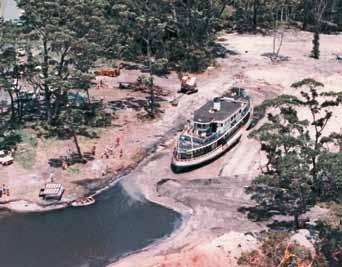
above left: Mrs Lane, daughter of a director of the Balmain Ferry Company, launches Lady Denman at Huskisson on 5 December 1911. Photograph from The Shoalhaven Telegraph
above right: Lady Denman back in Huskisson in 1983; a channel has been excavated to bring her onto land allocated to create a museum.
below: The museum in 2009. The ferry now resides in her own gallery and landscaping of the lawn where she was previously displayed in the open is underway. The complex’s enclosed saltwater fish reserve lies between the buildings and the mangrove-lined shore of Jervis Bay.
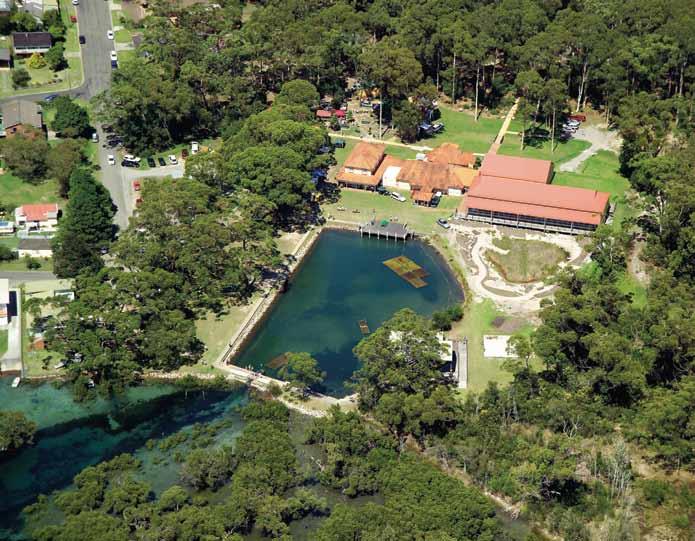
S I g NALS 97 D e C e MB e R 2011 T o F e BR u AR y 2012 45
Lady Denman was destined to be scrapped and probably forgotten by all but dedicated ferry enthusiasts


A three-sided ‘box’ was constructed with a heavy-duty waterproof concrete floor and walls. The floor was just below the level of the ferry’s keel next to where she sat buried to the waterline in sand. The sand was excavated and the whole area was flooded so that the ferry could be towed (by 200 local volunteers and a tractor) into her new home, with just a few centimetres clearance. Here she was supported on large steel cradles and the water was pumped away. Then the fourth wall of the box was built, along with upper walls and roof. Instead of putting a boat in a bottle, the bottle was built around the boat.
The ferry is accessible to the public while protected from the elements, and the below-waterline hull, its copper cladding, rudders and propellers can be seen close-up. The features of the Walter Reeks design are brought to life in a way that was not possible when the ferry was in the water or half-buried in sand.
The museum’s interlocking roles as a maritime museum and as a museum of place emerges in its Local History Gallery with five separate sections, each presenting a distinct theme. They encompass local stories of whaling, sea transport, shipbuilding, fishing, naval defence and tourism.
Aboriginal communities have inhabited the Jervis Bay area for over 20,000 years relying heavily on fishing for subsistence. Their traditional tools and crafts, as well as their modern experiences, are displayed in the Koori Coast section of the gallery. The Early Settlement section treats 19th- and 20th-century history and the link between land and sea through whalers, timber cutters, boat builders, coastal shipping and the navy (which came and went, before returning in the 1950s).
A third section houses a rare collection of boatbuilding tools and the story of Huskisson’s industry. Started by George
Dent in the 1860s, wooden boatbuilding lasted until the 1970s when Alf Settree built his last trawler. In addition to the Lady Denman we display another local boat, the fishing launch Ninon, also built in 1911. Both are listed on the Australian Register of Historic Vessels.
High cliffs, shoaling beaches and entrapping bays near Jervis Bay added to the dangers of southerly busters and east coast lows, and almanacs warned sailing ships against getting caught in Wreck Bay to the south. A shipwreck section displays items from prominent casualties Walter Hood and Merimbula, and tells the story of the Cape St George lighthouse that was built in the wrong place through incompetence and venality.
A final section called Grand Visions deals with history that never happened. Because of its geography, a number of major developments were proposed for the pristine waters of Jervis Bay: becoming a port for Canberra or the site for a nuclear power station, steel works and petrochemical plant, armaments depots and fleet bases.
By contrast the Science and the Sea gallery is more about a collection than a historical narrative. It contains the internationally acclaimed collection of surveying instruments and naval and maritime objects assembled by local businessman Warren Halloran, including a theodolite owned by Isambard Kingdom Brunel, the famous British civil engineer who designed and built bridges, tunnels, railways and the steamship Great Britain. There are also naval cutlasses, early navigation instruments, sailors’ crafts, commissioned maritime paintings of historical events in Jervis Bay by Ian Hanson, and much more.
Warren Halloran’s collection reflects his own family’s history, from a greatgreat-grandfather who served in the Royal Navy in the 1780s to his father Henry Halloran who had ambitious plans to create a new city and a port for Canberra in Jervis Bay. Warren ran the family company after his father’s death and assembled the collection piece by piece. It is now managed in a Trust by the museum.
The museum runs an active program of temporary exhibitions in a 150-squaremetre gallery, to build audiences and give a creative outlet for volunteers. Those created in-house are researched, designed and developed by volunteers on a minimal budget. This is a pattern of activity that has operated for many years at the Lady Denman complex, resulting in a talented pool of creative volunteers
S I g NALS 97 D e C e MB e R 2011 T o F e BR u AR y 2012 46
capable of producing high-quality permanent and temporary exhibitions, often accompanied by publications that expand on the content of the displays. One of these has just won the inaugural Frank Broeze Memorial Community History Prize (see story on page 40).
The Lady Denman museum complex has always been a community project. Huskisson has a population of only 800, and the surrounding villages another 3,000, but the museum currently has over 200 volunteers contributing over 3,000 hours a month of labour worth about $650,000 per year — a vital strategic asset in seeking grants. Our volunteering model is a simple one based on the pillars of trust, delegation, support and training. Governance is in the hands of an elected volunteer board that employs professional staff who are expected to build volunteer capabilities.
A recent example of this model at work is the Collection Management Centre. Funded by a mixture of reserve funds, government grants and in-kind volunteer labour, a major building program in 2010 created the 150-square-metre facility, with ample work space, a constant-climate room and extensive storage. Led by Denman curator Graham Hinton, the CMC team more than doubled in size within six months. Some brought specific skills such as photography and cataloguing. Others have acquired skills, mainly from the professional curator but also by attending workshops or winning internships. The team now carries out preventive conservation, ferry restoration and prepares objects for exhibitions, among many other duties.
Elsewhere, volunteers have created gardens, carried out maintenance on the grounds and buildings, managed regular fund-raising events, guided tour groups, run a visitor information centre, and organised the front desk. In short, they are involved in every aspect of the museum’s work. Why? There are no material rewards for being a volunteer, but there is great satisfaction in being part of a creative community and in giving visitors of all ages a memorable museum experience.
MMAPSS grants to the Lady Denman Heritage Complex have contributed to remedial works on the ferry and restoration of the forward saloon; environmental monitoring of museum facilities; documentation, conservation and interpretation of fishing launch Ninon; and developing a curriculum-related educational program for local schools.


top: Theodolite owned by the famous British civil engineer Isambard Kingdom Brunel, part of the Warren Halloran Collection.
above: Ship’s bell from Walter Hood, one of Wreck Bay’s best-known victims.
opposite top: Whaling artefacts from the early european Settlement exhibition
opposite bottom: Diving suit used on the south coast, now listed on the National Dress Register.
Jervis Bay whaling research project
A fellowship from the Powerhouse Museum, supported by the Australian National Maritime Museum, is enabling a post-graduate student to research the history of whaling in Jervis Bay. Claire Baddeley, a doctorate student of museum studies and public sector management at the university of Canberra, is basing her research on the collections of the Lady Denman Heritage Complex, the Nowra Museum and Shoalhaven Historical Society as well as the Australian National Maritime Museum. Among the outcomes of her work will be a temporary exhibition at the Lady Denman Maritime Museum on the history of whaling in Jervis Bay from the 1790s, on display from January 2012.
Whalers from Port Jackson and Tasmania began to anchor in Jervis Bay from the 1790s for fresh water, supplies and repairs. Regarded as Australia’s first primary industry, whaling contributed greatly to the economic, social and industrial development of NSW. The first on-shore whaling station was established in Jervis Bay in 1841. The development of steam and gun whaling in the late 1800s, and factory ships in the 20th century, had a significant impact on whaling in Australia, and Norwegian companies operated in Jervis Bay from 1912 to 1914. With the establishment of a naval college in 1914, Jervis Bay whaling operations ended. By the 1930s the protection of certain whale species commenced and since the international treaties of the 1970s, Jervis Bay has become renowned for its whale and dolphin watching, enhancing the local region through tourism and conservation.
Powerhouse Museum Moveable Heritage Fellowships stimulate research into the moveable heritage collections of regional New South Wales and increase skills in their interpretation and management. They raise awareness of the importance of community collections to understanding Australian society, and encourage tertiary students to work with community museums. In 2011 the Australian National Maritime Museum funded a second of these Moveable Heritage Fellowships, awarded to Claire Baddeley for her study of whaling in Jervis Bay. She will write about this fascinating subject in a future edition of Signals
S I g NALS 97 D e C e MB e R 2011 T o F e BR u AR y 2012 47
Australian Register of Historic Vessels
H istoric
Heroes of war, the America’s Cup and the olympic games

Fourteen craft were approved for listing on the Australian Register of Historic Vessels by the ARHV Council in September. Three of the new vessel listings are sculls – two having won olympic gold medals – and all three show the high-quality work of Australian builders from the past to present, says ARHV curator David Payne.
Australia has a proud record in Olympic rowing, winning gold medals at a number of Olympic Games since Bobby Pearce first triumphed in the single sculls in 1928 and 1932. He always used Australian-built sculls, a Towns boat in 1928, then an A&H Green boat in 1932, showing that Australia could build competition sculls to an international standard. This was repeated in 1948 when Merv Wood won the single sculls at the London Olympics in Kingfish, which is now on the ARHV. This scull was built by A&H Green at their Abbotsford yard in NSW. Wood also won the prestigious Diamonds single sculls race at the Henley Royal Regatta with Kingfish, held in the lead up to the Olympics.
The next rowing gold medal for Australia came in 1992 when Peter Antonie and Stephen Hawkins dominated the double sculls, despite being one of the lightest crews racing. They rowed Barcelona 92, a state-of-theart composite fibreglass scull built in Australia by Jeff Sykes in Geelong Victoria, showing that over 40 years later Australia still built craft of the highest quality. A third scull to be
nominated was probably never raced, but it was still built to a high standard in the mid-1930s by George Towns and Sons from Gladesville, NSW. It was clinker planked, rather than the usual construction of steamed panels of thin cedar, and was made stronger, wider and deeper to suit a much heavier rower who wanted the craft for exercise and recreational rowing.
Two yachts from widely differing backgrounds also highlight another two of the best boat builders Australia has had over the years. W M Ford Boatbuilders operated from the 1870s through to the early 1960s in Berrys Bay, North Sydney, and built many of the large yachts seen on Sydney Harbour. They catered for a wide range of clients and made numerous small craft. One of these was Wirraminna, a gaff rigged yacht from 1907 that spent decades sailing on Sydney Harbour. On the other hand, the International 12-Metre class racing yacht Gretel is one of Australia’s most recognizable yachts. Built in 1962 with great attention to detail by Lars Halvorsen Sons at Ryde on Sydney’s Parramatta River, Gretel challenged for the America’s
S I g NALS 97 D e C e MB e R 2011 T o F e BR u AR y 2012 48
www.anmm.gov.au/arhv This online national heritage project devised and coordinated by the Australian National Maritime Museum reaches across Australia to collate data about the nation’s extant historic vessels, their designers, builders and their stories.

Cup in September 1962, and surprised everyone by its performance. Its memorable win in the 2nd race, surfing past the American defender Weatherly, made headline news around the world, showing that the Americans were assailable and that Australian yachting was world-class in all respects.
Berrima represents the numerous workboats that toiled away behind the scenes and kept our waterside infrastructure functioning. In 1955 it started out on Botany Bay NSW as the workboat for the Caltex oil refinery at Kurnell, and was also contracted by the government to be the bay’s pilot cutter for many years. In contrast, the more luxurious and larger Shangri La began life as a cruiser for the Arnott’s biscuits family in the late 1930s, but soon was heavily involved with war service to the north of Australia. On its return to Australia it operated as a tourist launch from the late 1940s through to the 1970s, pioneering the tourist industry in northern Queensland.
LFB 457 and the Tacoma flattie are two very simply built craft that have been worked hard as fishing boats. Flat-bottomed and slab-sided, they were
quick to put together and easy to maintain. LFB 457 was built by owner Frank Cordie, and worked the rivers and shallow bays around Hervey Bay in Queensland.
The Tacoma flattie worked from its mother ship Tacoma (HV000151) in a dual purpose role. At sea it was used to collect live bait at night for deep water tuna fishing, but close to the shore it worked the surf break netting salmon, in conjunction with the Tacoma surf boat (HV000426).
As with the surf boat and the big Tacoma, the Haldane Bros built the flattie, modifying an American plan to suit their needs and the space aboard Tacoma Fishing is also the background for Songton and Edna Felice Songton is a classic mid-1950s Torres Strait pearling lugger that also collected trochus, and later served as a fishing boat, all in Northern Queensland waters. Down in the Great Australian Bight, the relatively diminutive Edna Felice, owned by one of Ceduna’s bakers and built in the late 1960s by well-known Port Lincoln shipwright Axel Stenross, fished on weekends out of Streaky Bay. It was built strongly enough to withstand the conditions in this remote region.
far left: gold medal winner at the 1948 London olympics, the single scull Kingfish is a treasured survivor. All photographs courtesy of current owners left: Shangri-La was built for the Arnott’s biscuits family and saw war service before becoming a pioneer of Queensland tourism.
Australians love all their recreational activities on the water, and the Val design of runabout spent its time in Sydney or nearby, trailed down to the water by its owner-builder who had purchased stock plans from a city store and built the plywood hull himself to a very high standard in 1962. Cosi Fan Tutti is an early example of the Northbridge Senior or NS14, a lightweight, two-person, highperformance sailing dinghy. The design began as a boat for a group of like-minded Northbridge Sailing Club members, and soon became a national class that remains one of the strongest in Australia. Norman Joel built the dinghy for a client in the mid-1960s at his Cromer, NSW, home, from plans drawn by class stalwart Frank Bethwaite.
Learning about the water starts at an early age for many Australians, and Spray was a gift from grandmother to grandchild back in the 1930s. Exquisitely made by an unknown builder, this canoe passed through three generations of the same family, providing hours of imaginative childhood adventures.
S I g NALS 97 D e C e MB e R 2011 T o F e BR u AR y 2012 49
Australian Register of Historic Vessels
Builder
Type

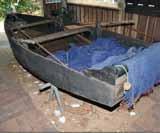
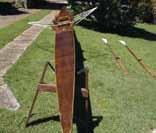











All photographs are reproduced courtesy of the vessel owner
Barcelona 92 1992 HV000479
Berrima 1955 HV000480
Builder Jeff Sykes Type Double scull
1962 HV000481
Val
1969 HV000482
Axel
Type Fishing boat Spray 1930s HV000483
unknown Type Child’s
Tacoma Flattie 1960 HV000484
Haldane Bros Type Fishing skiff Kingfish 1947 HV000485 Builder A&H green Type Single scull
1962 HV000471
Builder Cam Fisher and Sons Type Motor launch Val-design runabout
Builder Home-built Type
plywood runabout Edna Felice
Builder
Stenross
Builder
canoe
Builder
Gretel
Lars
Halvorsen Sons
12-Metre
LFB 457 1940s HV000472
Fishing
1930 HV000455
class yacht
Builder Frank Cordie Type
dinghy George Towns clinker scull
Shangri La 1938 HV000474
Walker
Motor
Songton 1956 HV000476
Hansen
Type
Wirraminna 1907 HV000477
W M Ford Boatbuilders Type yacht
Builder george Towns & Sons Type Single scull
Builder
and Kelshaw Type
cruiser
Builder
and Collis
Pearling lugger
Builder
1960s HV000478
S I g NALS 97 D e C e MB e R 2011 T o F e BR u AR y 2012 50
Cosi Fan Tutti
Builder Norman Joel Type Northbridge Senior

300 1 EXTRAORDINARY PEOPLE GOLD MEDAL CLUB MEMBERSHIP
The Perth 2011 ISAF Sailing World Championships are coming to Western Australia. Experience this Olympic Qualifying Event in style and become a Perth2011 Gold Medal Club Member today.

Join Gold Medal Club Ambassadors Elise Rechichi and Tessa Parkinson, the Women’s 470 Gold Medalists at the Beijing 2008 Olympic Games on the journey to the World Championships. Your membership includes:
• Your own seat in the Gold Medal VIP lounge, located on Bathers Bay (Centre Course).
• Mingle with Olympians, competitors, coaches and officials in this VIP area.
• A Leeuwin Estate Wine Tasting Function.
• Enjoy a special luncheon with the golden girls.
• A beautiful Membership package including the limited edition, award-winning Event book, a stunning white gold necklace and fashionable Perth 2011 cufflinks.
• Bonus offers from Perth 2011 sponsors, Kailis Jewellery, Holden and Little Creatures and many more.
• Includes a guest pass.
You can purchase this fantastic membership for only $990. Purchase online @ PERTH2011.COM or call (08) 9335 2688.








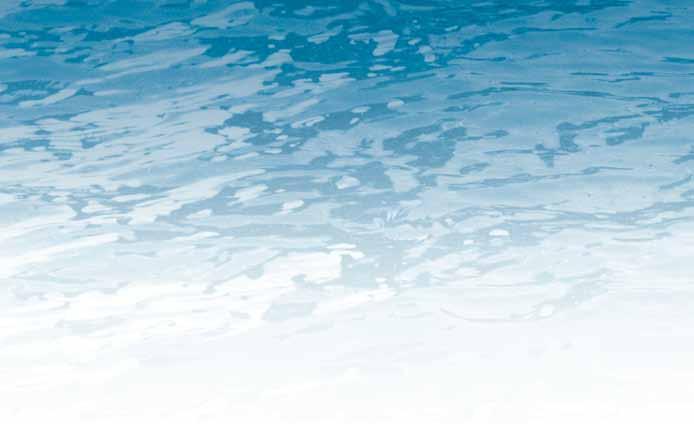

DMS Maritime Pty Limited Level 6, 210 Clarence Street, Sydney NSW 2000 Email: dmsinfo@dmsmaritime.com Telephone: 02 8001 1600 Facsimile: 02 8231 0172 www.dmsmaritime.com • Fleet operations and
• Fleet maintenance and management • Vessel and port services • Integrated logistics management • Marine systems support • Vessel build and modification • Maritime project management • Maritime training Total Asset Management: Skills, commitment + service delivery
2011
management
3-18DEC2011 PERTH
ISAF SAILING WORLD CHAMPIONSHIPS
THE DREAM BEGINS IN PERTH!
+61
9335 2688 E worlds@perth2011.com W PERTH2011.COM S I g NALS 97 D e C e MB e R 2011 T o F e BR u AR y 2012 51
P
8
Welcome
Against a sea of troubles
After the Vietnam War unified the country’s north and south, thousands of Vietnamese tried to escape the communist regime. The resulting flood of seaborne refugees gave rise to the term ‘boat people’. one of them, Kevin Tran, shared his memories with Welcome Wall contributor Veronica Kooyman


The lives of the southern Vietnamese changed irrevocably with the fall of Saigon to communist forces in April 1975. Tens of thousands of people associated with the former government were instructed to present themselves at re-education camps to learn about the new order. Welcome Wall registrant Kevin Tran’s father Tam, a public prosecutor in the old government, was one. Educated in the USA, he had spent many years abroad but despite the chaos in postwar Vietnam he chose to stay with his wife Ngoc Nguyen, two children and extended family. Like many others, after entering a camp in order to reconcile with the new regime he was neither seen nor heard from for more than 15 years. The re-education camps were in reality political prisons, places of indoctrination and revenge. Tam’s son Quoc Khanh (Kevin) was 16 years old when they claimed his father. The revenge also extended to the children of these men and women. Opportunities such as tertiary education were denied and manual labour was enforced, often on peasant farms. When Kevin finished his secondary studies with excellent results his only option was to study agricultural
economics with the expectation of eventually working on the land.
For an intellectual city boy this was an anathema. With no future in Vietnam, his mother convinced him to leave in 1979 – knowing that if she had not heard from him within six months then he would not have survived the journey. Thousands had already left, the lucky ones reaching overcrowded refugee camps in South-East Asia. Kevin and members of his extended family paid high fees to a syndicate to take the dangerous sea journey, with no idea of their destination and fully aware of the high risk of capture and punishment by police, or death at sea.
Kevin obtained a government permit to leave Saigon on the pretence of visiting a sick relative. He remembers wading through paddy fields and swimming through canals at night to avoid capture, virtually blind. Kevin had myopia but, since country people had no access to health aids, wearing glasses would have raised suspicion. In the Mekong Delta sampans, known as ‘small fish’, would collect two or three people each and carry them to ‘big fish’, wooden vessels up to 30 metres long. They carried containers of fresh water to swap for fish sauce from the larger vessel, so as to appear to be
involved in legitimate trade. Only Kevin and his young cousin Tony reached the rendezvous; other extended family members didn’t make it. On board the ‘big fish’ were more than 30 friends and relatives of the syndicate. In the harsh light of day it emerged that most of the containers on board the crowded vessel held undrinkable fish sauce; there was insufficient drinking water and no food. Surviving on one small sip of water a day, Kevin quickly realised he was in trouble.
Piracy was rife on the South China Sea and on the third day as they voyaged southwards the group was attacked by Thais who separated the men and boys from the women and girls and robbed them, looking for the gold, gems or jewellery that refugees often carried to help establish new lives. Kevin carried nothing but the sandals and thin clothing he wore. The pirates then humiliated and raped most of the women on board – although surprisingly they gave the refugees some food. The next day another pirate vessel attacked. They too assaulted the women. Convinced valuables were being concealed they ripped up planks to find any hiding places. They found nothing but left a ruined shell of a vessel that began to leak, forcing those on board to start bailing.
Tales
the wall
from
left: Kevin, wife Tracy and daughter Victoria at his graduation from the university of Technology, 2002.
right: Kevin as a child in Saigon during the Lunar New year in 1972.
far right: The refugee camp on Pulau Bidong, Malaysia, shown in 1981. Photograph courtesy of Department of Immigration and Multicultural and Indigenous Affairs.
S I g NALS 97 D e C e MB e R 2011 T o F e BR u AR y 2012 52
The museum’s tribute to migrants, The Welcome Wall, encourages people to recall and record their stories of coming to live in Australia
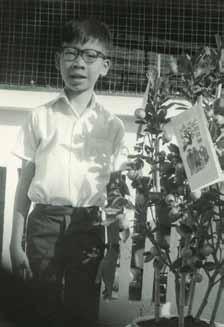

While those around him prayed, cried and said their goodbyes, Kevin remained calm, accepting his fate. They floated until 4 am that night, when the leaking boat struck a rock and sank. He vividly recalls the pervading darkness, the rapid sinking, the dim figures of those around him. Kevin and his cousin Tony clung to buoyant plastic fish sauce containers and as the first streaks of daylight broke they saw the shore of a remote island off Malaysia. Reaching the deserted beach, the group trekked into the mountains until they stumbled across villagers armed with machetes. But at last they found real help, as the villagers led them to a village and gave them food and water. That afternoon a team from the United Nations High Commissioner for Refugees (UNHCR) arrived by boat to collect them. Kevin, his cousin and the other refugees were taken to a crowded, make-shift refugee camp on the tiny island of Pulau Bidong. Immigration officials from western countries visited to interview and resettle the refugees. Kevin, fluent in French, applied for resettlement in France and Canada where other extended family members had migrated. His cousin Tony, desperate to leave the rudimentary camp, approached the Australian delegate.
Tony was too young to travel alone so Kevin, at 19, was also interviewed by the Australians. Neither spoke any English nor had any family here, but both were accepted under the Australian government’s humane policy towards refugees from the war it had entered as an ally of the USA. Soon afterwards, Kevin was told he had been accepted by France and Canada, too. Not wanting to disappoint the Australian case workers who had spent their time helping him, he chose Australia. Following medical checks they flew from Kuala Lumpur to Australia, in 1980.
Kevin arrived in Sydney with nothing but the clothes he wore. The government provided six weeks of hostel accommodation and English language classes, and after that he was on his own. Tony, 15, was placed with a guardian and enrolled in school. Kevin quickly found work and completed high school through TAFE. Since then he has pursued his academic dreams, achieving a degree in computing science, masters degrees in business administration and information management, and is currently completing a doctorate in business administration. He met Tracy Nguyen, also a refugee from Vietnam, while they were both
studying at UTS. In 1992 they married and their daughter, Victoria, was born six years later. Kevin has held senior and executive positions in the public service and private industry and has set up his own IT consulting company and a tutoring school in Sydney.
His father Tam was finally released in 1990 and now lives in Oregon, USA, with his wife and daughter. In 1995 Kevin and his family reunited; it was the first time he had seen his father in almost 20 years. In May 2010 Kevin’s name was unveiled on the Welcome Wall at the museum.
The Welcome Wall
It costs just $105 to register a name and honour your family’s arrival in this great country! We’d love to add your family’s name to The Welcome Wall, cast in bronze, and place your story on the online database at www.anmm.gov.au/ww. So please don’t hesitate to call our staff during business hours with any enquiries on 02 9298 3777.
S I g NALS 97 D e C e MB e R 2011 T o F e BR u AR y 2012 53
A most idiosyncratic artefact
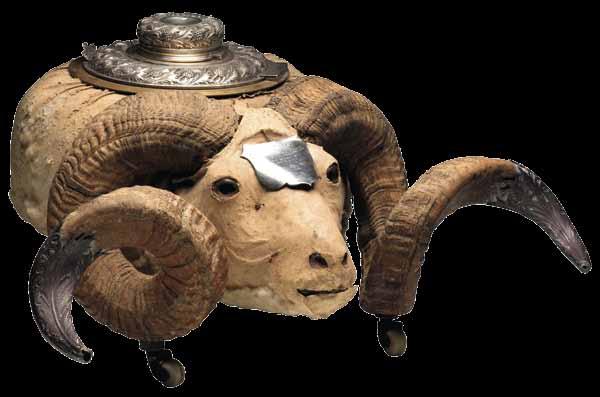
Recently gifted to the museum, this most unusual trophy is part of the growing collection related to competitive sailing in the Australian colonies and the development of massively canvassed, open-hulled racers in the late 19th century. It is everything that one would expect of a late-Victorian sailing trophy, writes senior curator Daina Fletcher.
In December 1896 a most remarkable trophy took pride of place in the offices of the John Walker Whisky company in Bond Street, Sydney. Made in Scotland by Edinburgh silversmiths Robert & Henry Bruce Kirkwood, it was built upon the actual head of a merino ram – an icon of the colony’s prosperity –that also had the utilitarian function of a cigar box for the drawing room table. It was brought to New South Wales by John Walker, the spirit distiller and official ale supplier to the Queen, for the Intercolonial sailing carnival.
The trophy caught the media’s attention. ‘It illustrates the ingenuity of the designer to a remarkable degree,’ reported The Sydney Morning Herald on 19 December 1986. ‘The ram, if one might judge by his enormous horns, must have had a distinguished pedigree.’ The horns were polished and the points fitted with silver ornamentation in the design of the thistle of its Scottish patron. The head cavity was furnished with a double canister, one fitted to receive cigars and the other to hold cigarettes. Its lid featured a cairngorm, or polished piece of quartz.
The company had sponsored rowing and sailing races in the colonies for more than 20 years and its new trophy, the Walker Whisky Trophy, was aimed at raising its profile among open-boat owners and sailors and the enthusiastic crowds who supported them, many of them from Sydney’s inner suburbs of Balmain, Glebe, Pyrmont and the city itself.
The Intercolonial Sailing carnival was organised by the Johnstone’s Bay Sailing Club of Balmain, then one of the harbour’s many inner-suburban openboat clubs. Others included textile entrepreneur Mark Foy’s Sydney Flying Squadron, the Sydney Sailing Club, and the Sydney Dinghy Sailing Club. The Johnstone’s Bay club fielded a range of open boats from six to 24 feet (1.82–7.31 metres) in length. Today’s legacy of that open-boat competition is the 18-Foot Skiff class but back then the glamour boats were the 22 and 24-footers, shallow-draught open boats with a length restriction but little else by way of rules, carrying huge rigs and great clouds of canvas. Their large crews worked hard to sail them, and functioned as live ballast.
Collections
S I g NALS 97 D e C e MB e R 2011 T o F e BR u AR y 2012 54
These boats had evolved from ship’s boats and tenders raced on the harbour in the growing colonial competitions, at a time when you could count on one hand the ‘first class’ or larger, decked, privately owned keel yachts. By the time American solo sailor Joshua Slocum visited Sydney on his famous 1895–98 solo voyage around the world, the open boats were widely acknowledged as a Sydney type. Slocum described their ‘great beam and enormous sail-carrying power... they carry sail like Vikings’.
The Intercolonial series was first held in the 1893–94 season, hosted in turn by Sydney and Brisbane. The Walker Whisky company first offered the Intercolonial trophy to the 22-footers, as the premier class, in the 1896–97 season, attracting 11 of the crack 22-footers from both cities. The first race was held on Sydney Harbour on 23 January 1897, with vantage points crowded by picnickers and eight steamers and numerous bunting-bedecked private vessels following the races. The Australian Town and Country Journal exclaimed that the event ‘saw the largest number of spectators ever seen afloat on the waters of our Harbour. Never before in the annals of Sydney aquatics has there been such an interest taken in a sailing race.’
The race and the £10 first prize was won by Balmain resident Mr A Kinnimont’s Irex skippered by Fred Doran, from Chris Webb in Figtree. The Queensland boats trailed the fleet on that occasion, either because of equipment failure or, as one commentator offered, because the breeze did not suit them.
The race the following year was held in Brisbane in January 1898 when it was won by Sydney sailing official James McMurtrie’s Effie skippered by N Johnson, who beat Irex and the Queenslanders. McMurtrie usually skippered his own boat but was suffering a bout of typhoid. Effie was built by Sydney builder Donnelly in 1886, 12 years old but still competitive. With its huge spread of canvas it often carried 20 crew.
Walker Whisky’s ram’s-head trophy was offered to the boat that won the event twice, which should have set the stage for a showdown between the two crack 22-footers, Effie and Irex, in March 1899. Irex, however, had had been shipped to the UK for another challenge so it was left to Effie to contest the trophy.
On 30 January 1899 on Sydney Harbour, Effie won the third and final race from a field of three Sydney and three Brisbane boats, so it was to McMurtrie that the Walker Whisky trophy went, presented at a concert to entertain the visiting Queensland crews.
By this time the size of the big boats, the cost of campaigning them and the domination of the New South Wales boats had dampened the interest of the Queenslanders, and there were fears the competition would die. Many clubs would champion the smaller 18-footers as the competitive craft for the coming century. Effie remained a champion for the next few years but the 22-footers were soon superseded.
The trophy was donated to the museum by the Wright Family of Roma, Queensland, through Donna and Ross Fraser & Lesley and Stanley Harrison. It had been found under a house at Tewantin, Queensland in the 1970s. Keen amateur historians piqued by the qualities of the trophy, Donna and Ross spotted a similar trophy when on holidays in the UK. Known as the Taymouth Ram, it was presented to the winner of the men’s open golf tournament day at Taymouth Castle Golf Course in Perthshire, Scotland. This serendipitous find sheds light on the Australian trophy and its origins – a Scottish trophy presented by a Scotch whisky company for the Australian colonies.
The museum is planning the conservation program for the trophy, which is missing much of its wool and some of its ornaments. More than 115 years after it first went on public display, the trophy will be prepared for an exhibit exploring the appeal of the regatta in colonial society and the open boats to which this idiosyncratic artefact of colonial adventure belongs.
left and top: Trophy inscribed ‘Presented by John Walker/22 Bond St/Sydney/To The Intercolonial Sailing Carnival/Won by/J Mcmurtrie’s ‘effie’/Sailed by N Johnson/ 1897–99’, 330 x 610 mm. ANMM Collection, gift from the Wright family. Photographer A Frolows/ANMM
centre: Effie racing on Sydney Harbour. Photograph by William Hall, date uncertain, ANMM Collection, transfer from the Mitchell Library.
right: From the Intercolonial regatta program of 1897. ANMM Collection



Collections
S I g NALS 97 D e C e MB e R 2011 T o F e BR u AR y 2012 55
Readings A well-seasoned history
Spice Islands – The history, romance and adventure of the spice trade over 2000 years
By Ian Burnet,
Rosenberg Publishing Pty Ltd, Sydney 2011. Hardcover, colour illustrations, bibliography, index, 200 pp. ISBN 97819221719110. RRP $42
The epic scope of this book is well conveyed by its subtitle – although you might query ‘romance’ after reading the catalogue of repetitive brutalities and massacres inflicted by one world power after another as they tried to monopolise by force the cultivation and trade of the world’s most valuable commodities. Indeed, if you were ever tempted by the romantic notion that our species’ heroic impulse to voyage and encounter new lands sprang from some deep, innate font of human curiosity, here’s a book to bring you back down to earth with the reminder that the vast bulk of such voyaging was driven by the bottom line – trade and wealth.
It’s quite difficult, in our superconnected world, to imagine a time when the upper-class consumers of two of the rarest and most sought-after goods on earth – the aromatic spices clove and nutmeg – had absolutely no idea where they came from. Shrouded by myth and deception, they grew nowhere else on earth but some tiny islands in a remote backwater of the East Indian archipelago – today’s Indonesia. It’s just as hard to imagine that food flavourings were worth more than gold or gems, and spurred warfare and a trade by land and sea that spanned all the known world and would launch Europe’s great age of sail. Cloves excavated from a kitchen in Syria, dated to 1721 BC, give this trade an extraordinary antiquity.
Author Ian Burnet spent over 20 years living and working in the Indonesian archipelago as a geologist and geophysicist, and his love for these fascinating tropical isles and their history is evident. It’s inspired him to take us with him on a voyage to the very centre of this story, the twin island sultanates of Ternate and Tidore rising from the Moluccan Sea, the fertile slopes of each

one’s central volcanic cone covered by shapely, shrub-like clove trees.
As with books about that fascinating English navigator James Cook (opposite), there’s no shortage of accounts of this complex trade, which scholars now consider the first instance of mercantile globalism. The archaeology of ancient ports and shipwrecks is expanding our knowledge of the trade’s maritime routes and their earlier navigators: the Austronesians (Malays and Indonesians), Arabs and Indians, Chinese, Greeks and Romans. Portugal and Spain enter the picture in the 15th century with their attempts to cut out the Muslim middlemen who straddled the route from the Far East to Venice – that wealthy Mediterranean emporium where Europe had previously been forced to shop for its spices. Then the northern navigators of Protestant England and Holland sail into the story, elbowing out their Catholic competitors while inventing the multinational corporation in the form of their East India companies.
What Ian Burnet’s concise, tasty history contributes to this literature is to make an epic tale digestible. He garnishes it with colourful illustrations and charts from all the ages, adding a sprinkle of
You might query 'romance' after reading the catalogue of repetitive brutalities and massacres inflicted by one world power after another
quotes from key players and observers. He stirs in a personalised treatment of the figures who created the globalised world that we have inherited – among them Marco Polo, Zheng He, Columbus and da Gama, d’Alburquerque and Magellan, Drake, Houtman and the cruel, cold Jan Pieterzoon Coen. And importantly, he relates the Indonesian side of the story as we meet sultans and regents and princes whose names are far less familiar, even though it was their islands, their livelihoods and lives – and, frequently, their spilled blood – that are at the centre of the tale.
Burnet offers deeper botanical and pharmacological insights into the spices themselves. Far more, in fact, than just seasonings and preservatives, they were prized as medicines, aids to seduction and even diplomacy (never speak to your monarch unless cloves disguise your halitosis!). And now they are grown widely around the world, thanks to one of Burnet’s memorable characters, the 18th-century Frenchman Pierre Poivre who picked a peck of clove and nutmeg seedlings and risked his neck to break centuries of monopoly by smuggling them out of the Dutch East Indies. Here’s a book to read this summer for a vicarious vacation to those elusive and legendary isles of spice. Just bring along a modern map of the Moluccas or eastern Indonesia to help locate them – one small addition I would like to have seen among this attractively produced book’s periodmap reproductions.
Jeffrey Mellefont
S I g NALS 97 D e C e MB e R 2011 T o F e BR u AR y 2012 56
The master mariner revisited
Captain Cook – Master of the Seas
By Frank McLynn, yale university Press, 2011. Hardcover, bibliography, index, xv + 490 pp, RRP $45. Review reprinted in abridged form with permission from The Great Circle
The Cook boom shows no sign of ending – and who can wonder, given the epic qualities and world historical themes that a study of Cook entails? Frank McLynn’s Captain Cook adds to the work of J C Beaglehole and more recent volumes another comprehensive and fullyresearched biography. It is not the work of someone trained in anthropology but it does try to look at Cook’s impact on the Pacific from both sides of the beach – even though one of the author’s aims is to rescue Cook from what he considers to be the anachronistic strictures of his post-colonial critics. Unlike Beaglehole, McLynn is on occasions quite critical of Cook, and sees such a decline in his behaviour on the third voyage that it prompts doubts about the great navigator’s psychological health.
Unsurprisingly, the book brings no new sources to light, although it is based on a full reading of the available materials both primary and secondary and acknowledges earlier scholars of Cook’s travels. The recent flood of Cook titles is generally taken into account, although there is no mention of works by O’Sullivan, Blainey nor, oddly, of the invaluable Cook encyclopaedia and maps produced by John Robson.
The book adds most to the existing literature in sections dealing with Cook’s rise from rural obscurity to the command of his first Pacific voyage. The author, an authority on 18th-century Britain, handles this deftly. The complexities of the Seven Years’ War – the backdrop to Cook’s surveying apprenticeship in Canada – are covered with great mastery and clarity. Earlier European ventures into the Pacific are also drawn with concise insight. McLynn is an accomplished narrative historian and provides vivid summaries of Cook’s Pacific voyages, bringing to life the ever-present dangers and Cook’s remarkable seamanship, flawed though it could be on occasions.
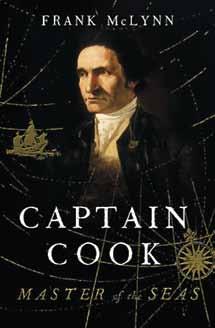
The quest for new approaches to Cook has, however, led the author to venture at times beyond charted territory into perilous, speculative waters. McLynn flirts with the notion that Cook’s patron, the local squire Thomas Skottowe, may in fact have been his father, and then dismisses it on the spurious grounds that we would have heard about it if Cook’s mother were so beautiful as to attract the squire’s attentions. It’s a jarring note. We are told that ‘Banks always entertained ambivalent feelings about [Cook]’, but this does not seem consistent with the great botanist’s contributions to Cook’s Endeavour journal, his support for Cook’s membership of the Royal Society and the award of its Copley Medal, and his active concern for Cook’s family after his death.
With the second Pacific voyage, speculation gathers pace. Of Banks’s attempt to smuggle a mistress aboard, McLynn remarks that this was with a view to dumping her in the Pacific when surplus to requirements. Banks certainly had his faults where women were concerned but we know that he operated by a gentlemanly code (admittedly a very male chauvinist one). The author then suggests that both instances where Adventure was separated from Cook ‘s
Although readers need to be wary of some of these forays into uncharted waters, this is a book that brings to life many aspects of Cook's life and times
Resolution were due to Tobias Furneaux’s desire to avoid the toil and danger of Antarctic exploration. The Admiralty did not think so, since these events did nothing to halt Furneaux’s subsequent naval career. The book moves from such unlikely speculations to the unthinkable: that Furneaux deliberately allowed his men to succumb to scurvy in order to compel Cook to make a landing.
Like Beaglehole before him, McLynn has no love for that admittedly very difficult duo on the second voyage, Johann Reinhold and George Forster, though any account ought to acknowledge how the Forsters turned their experiences into lasting scientific benefit. We are told that George Forster ‘served his apprenticeship many times over in the rites of Venus’ – not impossible but we have no reliable evidence of this.
And on the third voyage, McLynn’s confident account of the influence of the Hawaiian chief Kamehameha has only a very partial foothold in the source that is cited.
Although readers need to be wary of some of these forays into uncharted waters, this is a book that brings to life many aspects of Cook’s life and times. There are clear maps of Cook’s voyages at the outset and each chapter is prefaced by a contemporary (although uncaptioned) map. As befits Yale University Press it is well produced with a full scholarly apparatus.
Professor John g ascoigne, university of New South Wales
Readings
S I g NALS 97 D e C e MB e R 2011 T o F e BR u AR y 2012 57
Currents
Thistle sets sail on gaffers Day
A strong, blustery wind from the southwest drove low grey clouds into the bay. The sea was up, the wave tops streaked and driven by the cold and unrelenting wind, as two hardy souls prepared the half-decked sloop for another hard day’s work on Bass Strait fishing for the big, needle-toothed fish called barracouta…
Well, not really. It was actually a brilliant blue spring day on Sydney Harbour. The sun was out, the waters of Darling Harbour were sparkling and only the hint of a zephyr ruffled the surface when our crew of city dwellers arrived to prepare the museum’s ’couta boat Thistle for the biennial Gaffers Day Regatta run by Sydney Amateur Sailing Club. The altogether pleasant reality did not lessen our commitment to play our roles as late 19th-century ’couta fisherman. Period gear was organised by one of the crew, an ANMM curator known for his penchant for dressing up at the hint of an historical re-enactment… and once donned, turned us into hardened, weather-beaten fishermen ready to face the elements. We may have numbered seven (five more than the traditional crew), and have had a museum support vessel to accompany us, but we were ready for any hardship and dangers that we might encounter.
Thistle, believed to date from 1903, was built to meet the unique requirements of the fishery for barracouta (Leionura atun). The boats sailed from Queenscliff and San Remo at the entrances to Port Phillip and Westernport Bays, and most of the ports westward along Victoria’s long, gale-swept lee shore known as ‘the shipwreck coast’. Thistle is one of the oldest of the type still sailing. Built in Maribyrnong, an inner suburb of Melbourne, she spent most of her working life at Port Fairy, a small fishing village at the end of the Great Ocean road 300 km west of Melbourne. The boat’s name has a strong connection with this coast, since an earlier Thistle was wrecked in 1837 when driven ashore in a gale at location that was to become known as Port Fairy Bay.
Our Thistle was located in 1986 lying on the Moyne River at Port Fairy in a

dilapidated state, and was meticulously restored to her original condition by the noted Victorian shipwright Tim Phillips for accession into the National Maritime Collection. Tim has been instrumental in resurrecting the ’couta boat class, restoring surviving examples or building new ones and leading to what now might be considered a ’couta boat cult in Victoria where they are vigorously raced.
No static display for a dimly lit exhibition space, the museum’s Thistle was intended for display on the water, both alongside at the museum’s Darling Harbour wharves and on the harbour, sailing with the same simple lug rig that she had when she was a working boat.
That brings us back to the Gaffers Day Regatta, and the glorious opportunity it provides for the museum to sail Thistle on the harbour, putting her on display to an audience that is both knowledgeable and appreciative, and committed to the preservation of Australia’s maritime heritage. The organising club, the Sydney Amateur Sailing Club, was founded in 1872 and is one of the oldest yacht clubs in Australia. The superbly organised and promoted regatta provides a unique ‘living history’ event for heritage vessels, particularly those that ‘hoist a spar’, to sail
in numbers and company on the harbour. To be able to ‘live the history’ is one of the primary reasons for restoring Thistle, or any heritage vessel, to an operational condition. The vessel is afloat, rigged and equipped as she was in 1903, with no modern conveniences such as an engine to drive the boat when the wind drops, or winches to haul the sails when it blows. We no longer have to imagine what it was like to rig and sail such a vessel. It leaves us only to imagine what it was like to live the life of a ’couta fisherman. So where were we? Ah yes: a strong, blustery wind was blowing from the southwest…
Postscript: There was a moment after the starter’s gun when Thistle, at the favoured end of the line, may briefly have been adjudged as coming second. However, with a light and lessening breeze, our cotton mainsail in need of recutting after more than 20 years of service, the extra weight of all those additional museum crew members, and the lighter boats dwindling slowly into the distance, we decided it was best to concentrate on our duties of display.
Peter Rout, assistant director, operations division (back to camera, hand on tiller)
S I g NALS 97 D e C e MB e R 2011 T o F e BR u AR y 2012 58
Craving sustainable seafood
In October the Australian National Maritime Museum took part in the annual Crave/Sydney International Food Festival, creating an event that reflects our efforts to raise awareness of environmental issues as part of the interpretation of Australian fisheries, within the theme of maritime commercial history. The event, billed ‘Sunset sustainable seafood’, was held on board the helideck of museum destroyer ex-HMAS Vampire It featured a menu created by celebrity chef Tom Kime who is the author of Fish Tales: stories & recipes from sustainable fisheries around the world
Tom, who runs fish&co the sustainable seafood cafe, has worked with the Marine Stewardship Council, a world program that has developed a standard for certifying wild-caught seafood and identifying well-managed, ecologically sound fisheries. Tom’s menu for our food festival event featured species that have been certified as sustainable, such as Australian Coorong yellow-eye mullet (Aldrichetta fosteri) and Vietnamese clams (Meretric Iyrata).
As Tom related to guests, the South Australian Lakes and Coorong fishery of the lower Murray River system ‘is a very hands-on fishery, giving the fishermen an extremely close relationship to the ecosystem, which makes them ideal stewards for this resource’.
According to the United Nations Food and Agriculture Organisation, over a quarter of the world’s fisheries are being overfished or are already depleted, a crisis that requires an urgent response. Over 100 fisheries from all over the world and many seafood suppliers are using MSC labelling to demonstrate that the seafood they supply is responsibly sourced.
In the museum’s Commerce exhibition, in a gallery examining Australian fisheries, we make available a brochure produced by the Australian Marine Conservation Society which allows visitors to identify for themselves which species are the most sustainable, and some of the questions that we can ask our fishmongers to ensure that our consumption is not accelerating the depletion of stocks.


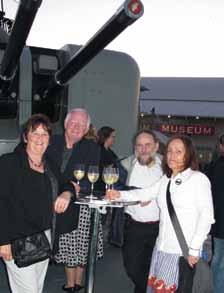
Currents
S I g NALS 97 D e C e MB e R 2011 T o F e BR u AR y 2012 59
Top: Sustainable chef Tom Kline addresses guests on the Vampire helideck, accompanied by Tooni Mahto of the Australian Marine Conservation Society. Photography J Mellefont/ANMM Museum Members and guests in attendance, bottom row, left to right: gudula Terhi and Hakola Dornseifer-Szekely; Margaret and David Brian; Martin Byrne and Caroline Staples.



above left: In September the Australian National Maritime Museum won the prestigious 2011 IMAgine Award for best exhibition, for our 2010 show On their own: Britain’s child migrants. The award was presented by Museums and galleries NSW, Museums Australia (NSW), Regional and Public galleries NSW and Museums Australia, with stiff competition from excellent programs by the Art gallery of NSW, the Powerhouse Museum and the Museum of Contemporary Art. On their own was developed as a collaboration with National Museums Liverpool in the uK and is currently touring venues in Australia before travelling to the uK. ANMM curator Kim Tao (centre) is pictured with the IMAgine Award. She’s with ANMM director Mary-Louise Williams (left) and Roxanne Lambie of Museums and galleries NSW.
Photographer Mimi Kelly MAgNSW.
above right: Paddy Crumlin, President and National Secretary of the Maritime union of Australia, was the special speaker at the annual World Maritime Day celebrations held at the museum on 27 September. For nearly 20 years the museum has collaborated with MuA to hold the annual event that marks the sacrifices made by merchant mariners both in war and peacetime, including those lost off the Australian coastline to submarine attacks. Photographer J Mellefont/ANMM
left: Inspecting the famous World War II commando raider Krait which was out of the water for hull repairs at Sydney City Marine, Blackwattle Bay, before being the centrepiece of the annual Remembrance Day service held at the museum on 11/11/11. The historic ship is cared for and operated by ANMM for its owner the Australian War Memorial. Inspecting her were (right to left): AWM chairman general Peter Cosgrove ac mc; AWM head of conservation Barbara Reeves; ANMM director Mary-Louise Williams and the new owner of Sydney City Marine, businessman and international yachtsman Syd Fischer. Photographer A Frolows/ANMM
Currents
S I g NALS 97 D e C e MB e R 2011 T o F e BR u AR y 2012 60
P&O Cruises can trace its heritage back 175 years to the formation of the Peninsula Steam Navigation Company which held the British Government contract for a weekly mail service to the Iberian Peninsula. In 1840 the company was renamed the Peninsular and Oriental Steam Navigation Company – creating P&O.
At this time ships were built for the purpose of transporting cargo and passengers only travelled out of necessity. However, thanks to the vision and innovation of Arthur Anderson and Brodie McGhie Willcox the concept of leisure cruising was born.
Today, P&O Cruises strive to innovate and improve much like its forefathers to cater for an ever-growing number of passengers and to provide an unforgettable holiday experience for everyday Aussies.
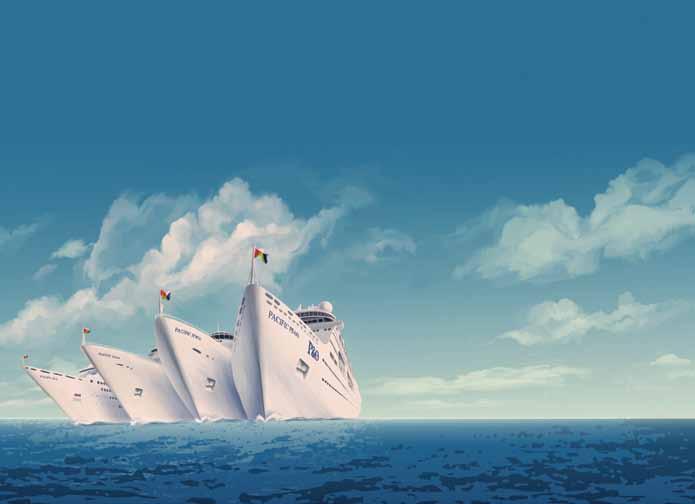
history, visit pocruises.com.au





P&O
www.amsa.gov.au S I g NALS 97 D e C e MB e R 2011 T o F e BR u AR y 2012 61
For more information on
Cruises’

Share in the excitement when you meet our Zoo Keepers and the magnificent animals in their care. There are 20 talks and shows a day, all free with admission, and each has a tale of conservation that will move you.You’ll be amazed how much there is to do and see at Taronga Zoo.
Buy tickets and plan your visit at taronga.org.au
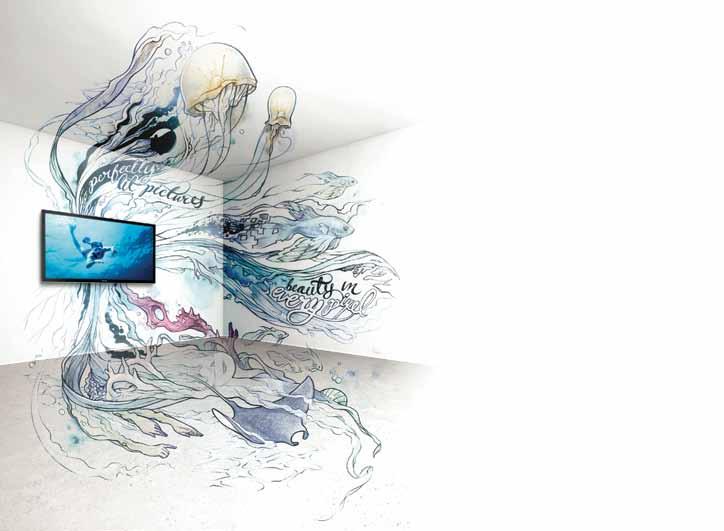

Intensify your experience.
Imagine a 3D/HD TV crafted by design house Jacob Jensen that marries leading design with leading innovations. Innovations like Toshiba’s revolutionary CEVO-Engine, optimising colour and brightness, meaning you will watch the truest, richest pictures available on television. Coupled with 2D to 3D conversion, personal video recorder and mobile interactivity, the latest WL series makes the television come alive. That’s Toshiba Thinking.
For more details visit www.mytoshiba.com.au
They'll
laughing, gasping
cheering.
have you
and
* Free access with purchase of Zoo admission tickets. FREE 20
A DAY * S I g NALS 97 D e C e MB e R 2011 T o F e BR u AR y 2012 62
KEEPERTALKS AND SHOWS
Nicole wins orion expeditions’ Antarctic voyage of a lifetime
A 25-year-old museum visitor, Nicole Schmulian of Petersham, has won a dream holiday adventure to Antarctica donated by museum partner Orion Expedition Cruises in a competition held in conjunction with our recent major exhibition Scott’s last expedition. Nicole, pictured here with Orion Expedition Cruises general manager sales and marketing Chris Perkins, entered the competition during a visit to the museum to view the exhibition, which was a collaboration between ANMM, the Natural History Museum (London), Canterbury Museum, Christchurch (NZ) and the New Zealand Antarctic Heritage Trust.
The prize, donated by Orion Expedition Cruises, entitles Nicole and a guest to a suite on the ‘Scott and Shackleton’s Antarctica – Ross Sea’ expedition valued at nearly $60,000, departing on 25 January 2013. The voyage, 100 years after Captain Robert Falcon Scott’s tragic death returning from the South Pole, covers polar regions famously charted during the epic race to the South Pole by Scott and his Norwegian rival Roald Amundsen – the subject of our
recent exhibition. As well as voyaging across the Ross Sea, Nicole will also visit the sub-Antarctic Macquarie Island with its large colonies of penguins and elephant seals.
Nicole, who works nearby in Pyrmont at a digital advertising agency, is a frequent visitor to the museum. She came to see Scott’s last expedition with her boyfriend and his parents, who were visiting Sydney. Having seen the re-creation of Scott’s hut in the museum’s exhibition, Nicole will have the opportunity to visit the real hut at Cape Evans as well as Shackleton’s hut at Cape Royds.
The competition was drawn by museum director Mary-Louise Williams from more than 6,000 entries received during the four months that the Scott exhibition was showing. When a video of the draw went live on our website, Nicole emailed it to all her friends and colleagues at work who at first thought it was a joke. A keen traveller who recently came home from a holiday in South-East Asia, Nicole is looking forward to seeing the amazing wildlife in Antarctica, joined by her boyfriend.
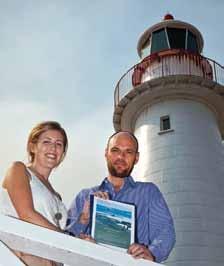
Sponsors Museum sponsors Major sponsors Austereo Blackmores Ltd Nine entertainment Lloyd’s Register Asia olbia Pty Ltd SBS Sydney Catchment Authority Project sponsors ACP Magazines Take 5 APN outdoor Coral Sea Wines orion expeditions Qube Logistics Rova Taxis Silentworld Foundation Sydney by Sail Wilhelmsen Investment group Foundation sponsor ANZ Corporate Members Founding patrons Alcatel Australia ANL Limited Ansett Airfreight Bovis Lend Lease BP Australia Bruce & Joy Reid Foundation Doyle’s Seafood Restaurant Howard Smith Limited James Hardie Industries National Australia Bank Pg, Tg & Mg Kailis P&o Nedlloyd Ltd Telstra Wallenius Wilhelmsen Logistics Westpac Banking Corporation Zim Shipping Australasia Partners in the HMB Endeavour circumnavigation 2011–2012 The program provides Corporate Members privileged entry to the museum’s unique environment for corporate hospitality. Three membership levels each provide a range of benefits and services: Admiral three-year membership $10,000 one-year membership $4,000 Commodore three-year membership $5,000 one-year membership $1,850 Captain three-year membership $1,800 one-year membership $700 Captain Memberships Asiaworld Shipping Services Pty Ltd Australia Japan Cable Ltd Defence National Storage-RPA google Australia HMAS Creswell HMAS Kuttabul HMAS Newcastle HMAS Vampire Association Maritime union of Australia (NSW Branch) Maritime Mining & Power Credit union Maruschka Loupis & Associates Penrith Returned Services League Sydney Ports Corporation Regimental Trust Fund, Victoria Barracks Royal Caribbean & Celebrity Cruises Svitzer Australasia Significant voyage partners Toshiba The History Channel Perth 2011 (ISAF) Department of education, employment and Workplace Relations Voyage partners Caltex Carnival Australia Australian Maritime Safety Authority NSW Maritime Defence Maritime Services Pty Ltd Taronga Conservation Society Australia Media partners The West Australian Austereo Channel Nine Voyage supporter Seaswift Pty Ltd
S I g NALS 97 D e C e MB e R 2011 T o F e BR u AR y 2012 63
Antarctic adventure-holiday winner Nicole Schmulian receives her prize voucher from orion expedition Cruises general manager sales and marketing, Chris Perkins. Photographer A Frolows/ANMM

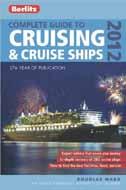


Cruise Ships Fourth edition
Special import! Recently released new edition of highly popular reference book by William Mayes. Comprehensive collection of information on cruise ships currently in operation globally. Accompanied by beautiful colour photographs of ships in port and on voyages around the world. In this edition, the book covers more than 700 ships. With hard-cover binding and glossy pages, this book is a must for anyone interested in the world of cruising.
$79.95 Members $71.96
Berlitz Complete Guide to Cruising and Cruise Ships 2012
New 2012 edition. Internationally recognised as the definitive cruise guide, this book is written by the accomplished cruise guru, Douglas Ward, the world’s most highly regarded expert on cruising who is considered to be the only source of independent star-rating for oceangoing cruise ships worldwide.
$59.95 Members $53.96

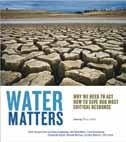

Titanic Love Stories
The legacy of the ill-fated Titanic is now almost synonymous with the fictionalised love story of the famous movie. But what about the real couples aboard the ocean liner? Among the passengers were 13 couples on their honeymoon, full of hope for a future together. In the case of six couples, both survived. Four couples saw the death of the husband and the survival of the wife. And tragically, three couples died. each story is rich in personal and historical detail.
$28.00 Members $25.20
The Happiest Refugee Anh Do is one of Australia’s leading comedians. He has also acted in television series and films, written screenplays and is a sought-after keynote speaker. His unique and inspirational experience leaving Vietnam as a toddler and growing up in Australia is the subject of his bestselling and award-winning memoir, The Happiest Refugee. $33.00 Members $29.70
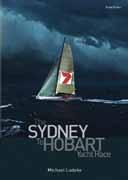

Transit of Venus: 1631 to the Present
The transit of Venus across the sun in June 2012 will be the last chance in our lifetime to see this rare planetary alignment that has been so important in history. Rich in historical detail and cutting-edge science, Sydney astronomer Nick Lomb takes us on a thrilling journey of terrestrial and celestial exploration and adventure.
$49.95 Members $44.96
Water Matters
Who controls our water and how much do we have left? Can we change our personal lives, our policies and our laws to protect our remaining reserves? Can we learn to share water equitably with each other and the planet? Water Matters will inspire you to do everything you can to preserve and protect our threatened water resources.
$39.95 Members $35.96
The Illustrated Longitude
Special import! An elegant essay on the historically vexing problem of determining longitude and the solution developed by master clockmaker John Harrison. It’s a captivating story of marine chronometers, Byzantine 18th-century British politics, and the age of sail. Hundreds of drawings, photographs and illustrations.
$49.95 Members $44.96
The Sydney to Hobart Yacht Race
This new and third edition of The Sydney to Hobart Yacht Race includes updated race summaries, statistics and race results from the first event in 1945 (which included the ketch Kathleen Gillett, sailed by artist Jack earl and now owned by the Australian National Maritime Museum) up to, and including, the 2010 race. This book is the perfect companion to our annual Members cruise to view the race start on Boxing Day. $49.95 Members $44.96
Cruiser
The definitive biography of the Australian cruiser HMAS Perth, and the brave men who sailed with her. of all the Australians who fought in the World War 2, none saw more action nor endured so much of its hardship and horror as the crew of the cruiser HMAS Perth
$38.00 Members $34.20
S I g NALS 97 D e C e MB e R 2011 T o F e BR u AR y 2012 64







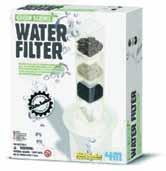

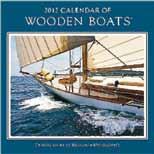
Hundreds of books something for everyone from key rings to ship models and boating clothes friendly service mail order Members discounts! open 9.30 am to 5 pm seven days a week Phone 02 9298 3698 or fax orders to 02 9298 3675 or email thestore@anmm.gov.au

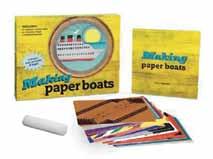
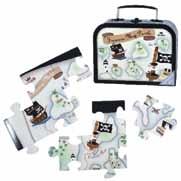

anmm.gov.au
shop online at
Learn the science of cleaning and recycing water $33.00 Members $29.70 80-page instruction, 50 sheets of pre-printed origami paper $20.00 Members $18.00 Quality dress-up pirate suit, comes with all the gear plus Jolly Roger $39.95 Members $35.96 Re-usable ANMM KeepCup for a sustaining yet sustainable coffee fix $19.95 Members $ 17.96 12 types of boats, great for bathtub, suits ages 3 to 90 $20.00 Members $18.00 Mermaid stationery set features your favourite mythic creature $33.00 Members $29.70 Brass and granite armillary sphere and compass height 42 cm $495.00 Members $445.50
birthday mug, guide book, note pad and postcards Special Members price $25.00 2012 calendar features all-new Benjamin Mendlowitz classic images $30.00 Members $ 27.00 glass wave sculpture. each piece is individual so colours vary $39.95 Members $35.96 Pirate treasure map jigsaw puzzle in carry box, 24 pieces $25 Members $22.50 Brass ships clock and optional stand $270 Members $243 (Stand $49.95 Members 44.96)
20th
Australian
ANMM
Chairman
Ms
Dr
Ms
Advertising
Back




National Maritime Museum open daily
Day
except Christmas
Darling Harbour Sydney NSW Australia
9.30 am to 5 pm (6 pm in January)
Phone 02 9298 3777 Fax 02 9298 3780
council
Peter Dexter
Ms Mary-Louise Williams Councillors
John Coombs
Admiral Stephen gilmore
csc ran
Peter Harvie
Mr
am Director
Mr
Rear
am
Mr
Robyn Holt
Julia Horne
Ann Sherry ao
Shane Simpson am
eva Skira
Neville Stevens ao
Mr
Ms
Mr
Jeffrey Mellefont
editor Penny Crino
photographer Andrew Frolows Design and production Austen Kaupe Printed in Australia by Bluestar Print
Signals ISSN 1033-4688 editor
02 9298 3647 Assistant
Staff
enquiries
issues
Jeffrey Mellefont 02 9298 3647 Deadline end of January, April, July, october for
March, June, September, December
Signals back issues
issues
back issues
extra copies of current issue
Call Matt Lee at The Store
Material from Signals may be reproduced only with the editor’s permission 02
The Australian National Maritime Museum is a statutory authority of the Australian government Contact us at gPo Box 5131 Sydney NSW 2001 Australia Connect with us online www.anmm.gov.au
$4 10
$30
$4.95
02 9298 3698
9298 3647






































 top: Endeavour crew relax ashore at Hinchinbrook Island en route to Cairns. bottom: Voyage
top: Endeavour crew relax ashore at Hinchinbrook Island en route to Cairns. bottom: Voyage










































































































































